The Rio Grande Valley or RGV is a remarkable place to observe and enjoy birding. Numerous species of birds can be found in this region due to its location near the Mexican border, providing a unique mix of habitats with tropical, subtropical, and arid environments.
The area is home to a great variety of bird species ranging from resident species like the Green Jay and Plain Chachalaca to migratory birds such as Painted Bunting and the Red-crowned Parrot.
Several of these birds are threatened or endangered due to habitat loss and other human-induced factors.
With its diverse avian community, the RGV has become a popular destination among bird enthusiasts, wildlife photographers, researchers, and tourists. This article will discuss some of the most iconic birds of the RGV and their habitat in this unique region of Texas.
1. Neotropic Cormorant
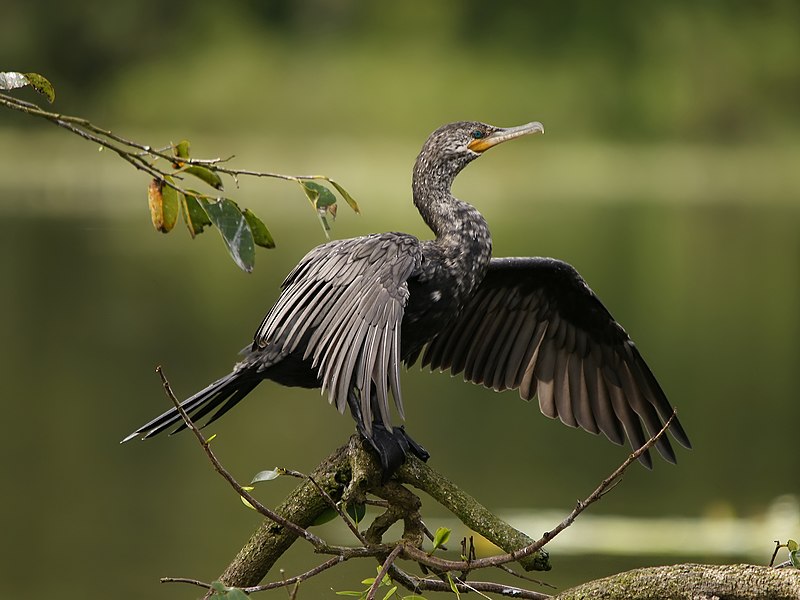
The Neotropic Cormorant, also known as the Olivaceous Cormorant, is a medium-sized bird found in tropical and subtropical regions of Central America, South America and the United States.
It can be identified by its black body with bright yellow facial skin on both sides of its large bill. The tail feathers are short and squared off at the tip.
This species breeds mainly on coasts but will sometimes nest inland near rivers or lakes during certain parts of their life cycle.
They feed mostly on small fish caught while diving underwater but can also eat crustaceans, amphibians and insects.
These birds roost in trees at night to keep safe from predators like foxes which prey upon them when they sleep close to water sources during daylight hours.Scientific classification:
| Kingdom | Animalia |
| Phylum | Chordata |
| Class | Aves |
| Order | Suliformes |
| Family | Phalacrocoracidae |
| Genus | Nannopterum |
| Species | N. brasilianum |
Also Featured In: Beautiful Brazilian Birds, Rainforest Birds You Should Know
2. Great-Tailed Grackle
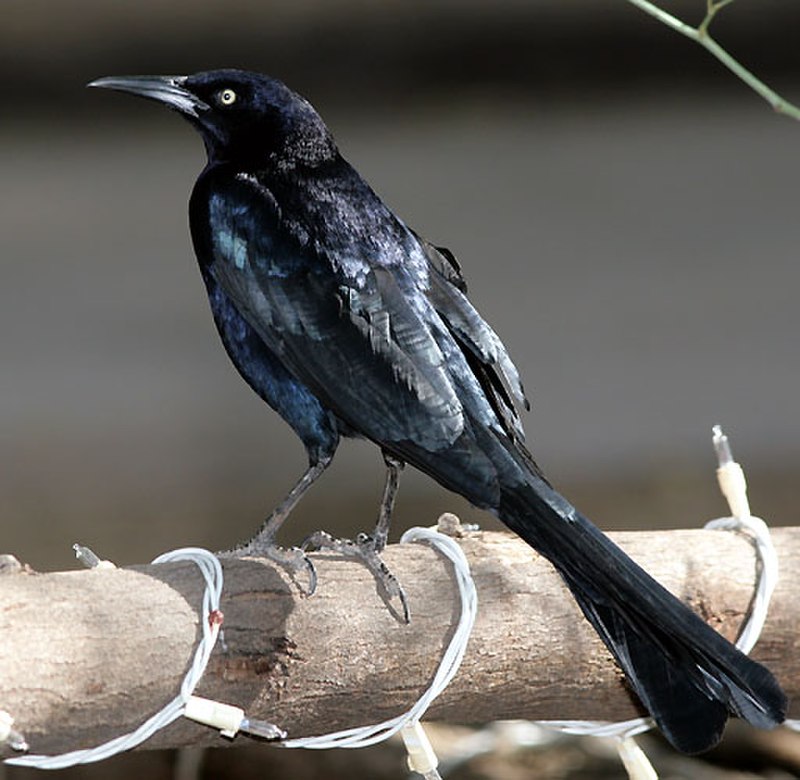
The Great-tailed Grackle is a medium sized bird native to North and South America. It belongs to the family Icteridae, making it closely related to two other species of grackles – the Boat-tailed and Slender-billed.
They are highly social birds which often appear in large flocks or colonies.
Their plumage ranges from glossy black with blue or purple iridescence, through brownish grey shades depending on location.
In some areas they have been known as “blackbirds” due their predominately dark colouring.
This adaptable species is also renowned for its distinctive long tail feathers – hence its name.Scientific classification:
| Kingdom | Animalia |
| Phylum | Chordata |
| Class | Aves |
| Order | Passeriformes |
| Family | Icteridae |
| Genus | Quiscalus |
| Species | Q. mexicanus |
Also Featured In: Top Birds Found in Mexico, Common Birds That Live in Las Vegas
3. White-Winged Dove
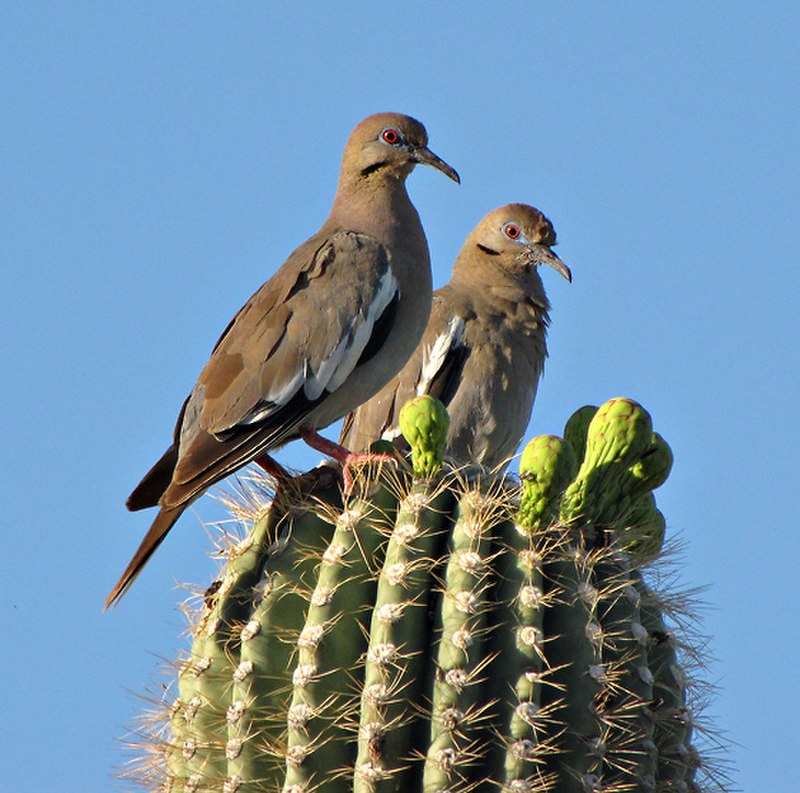
The White-winged Dove is an impressive bird with a large body and wingspan. Its distinctive feature is the white edge on its wings, which makes it easily recognizable when in flight.
It has blue eyerings, red eyes and gray plumage, while juveniles are duller in coloration than adults.
This dove species inhabits areas from Southwestern United States through Mexico to Central America as well as Caribbean islands.
They usually live close to human settlements or cities but can also be found in agricultural fields feeding on grains like corn or wheat seeds left by farmers after harvest season ends.
In their natural habitat they feed primarily on insects, fruits and small plants such as certain cacti species.Scientific classification:
| Kingdom | Animalia |
| Phylum | Chordata |
| Class | Aves |
| Order | Columbiformes |
| Family | Columbidae |
| Genus | Zenaida |
| Species | Z. asiatica |
Also Featured In: Common Birds of Houston, Small Birds of Texas
4. Inca Dove
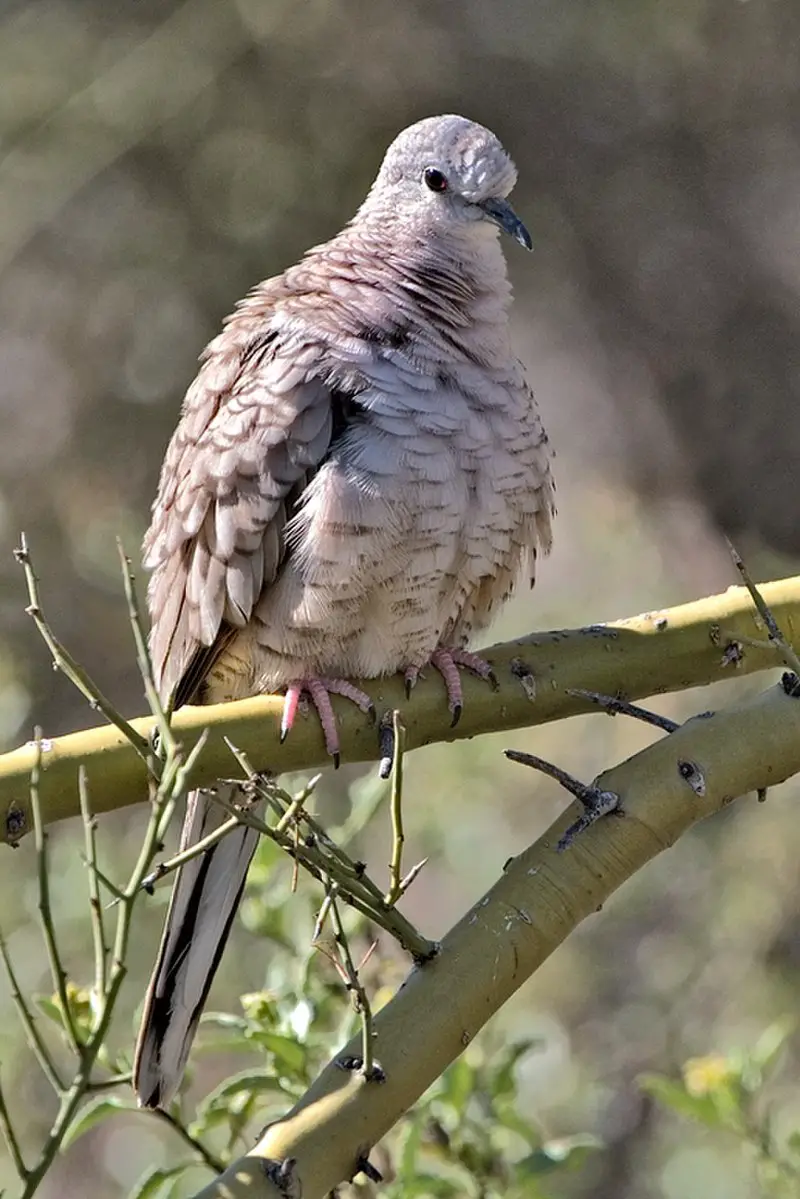
The Inca Dove is a small, slender bird found in the New World. It has an average length of 16.5–23 cm and weighs about 30-58 gm. Its wingspan measures around 28.5cm but can reach up to 32cm at max.
The body of this dove is grayish brown with feathers that are rounded off tips giving it a soft look overall.
This species was first described by French surgeon and naturalist René Lesson back in 1847 and since then have been living happily all over North America from Mexico through Texas to South Dakota, Kansas as well as parts of Arizona among others regions too.Scientific classification:
| Kingdom | Animalia |
| Phylum | Chordata |
| Class | Aves |
| Order | Columbiformes |
| Family | Columbidae |
| Genus | Columbina |
| Species | C. inca |
Also Featured In: Birds that You’ll Find in Chiapas, Birds You’ll Find in Sonoran
5. Lesser Goldfinch
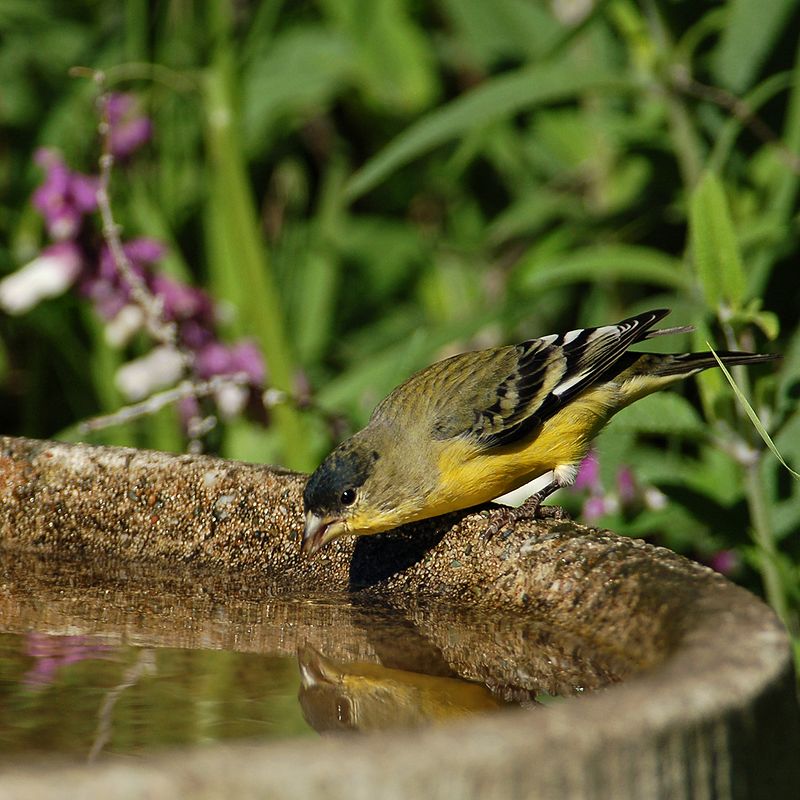
The Lesser Goldfinch is a tiny species of bird found in the Americas. It belongs to the same clade as American goldfinches and Lawrence’s goldfinches, which can be identified by their males having black or rarely green foreheads.
The face appears red or yellow on these birds unlike other species in its genus Spinus sensu stricto.
They are small songbirds with short bills, brown wings and tails with white edges, grey-brown backs and olive heads.
These birds inhabit open woodlands and fields where they feed mainly on seeds from weeds such as thistle, pigweed and ragweed but also consume insects at times during breeding season for additional nutrition.
In addition to being an important part of North America’s avian ecology, these birds have been popularized through recent artwork depicting them in various poses among flowers.Scientific classification:
| Kingdom | Animalia |
| Phylum | Chordata |
| Class | Aves |
| Order | Passeriformes |
| Family | Fringillidae |
| Subfamily | Carduelinae |
| Genus | Spinus |
| Species | S. psaltria |
Also Featured In: Birds That Live in Colorado, Birds Live Near San Diego
6. Reddish Egret
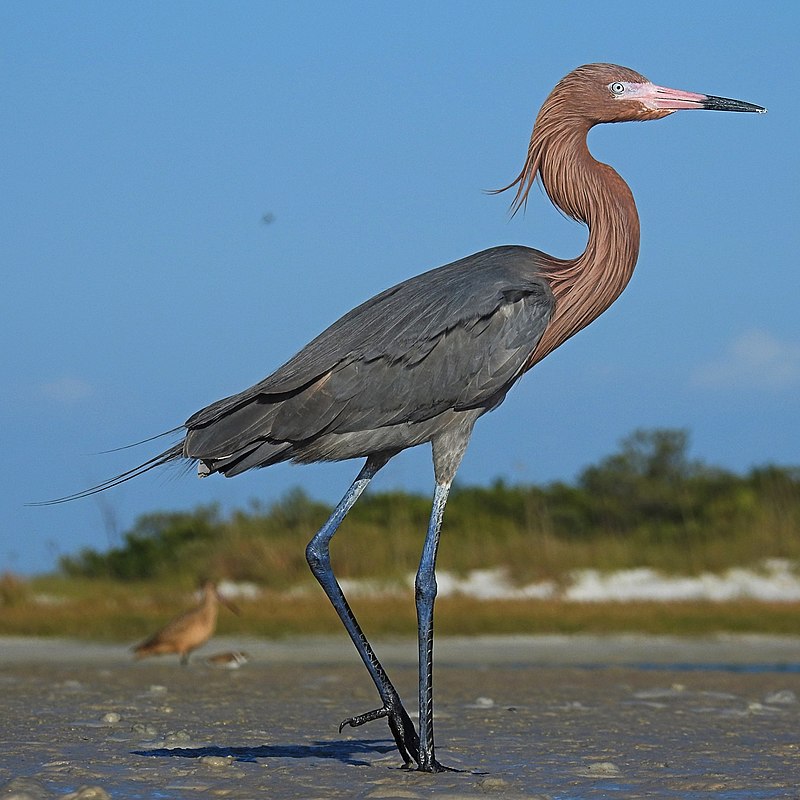
The Reddish Egret is a medium-sized heron that breeds in Central America, The Bahamas, the Caribbean, Texas and Mexico.
It prefers mud flats as its habitat of choice due to its unique foraging behaviour which differs from other herons.
In the past it was hunted widely for its feathers used to make fashionable hats but thankfully this practice has now been stopped.
They have white or grey plumage with pink legs and bill giving them their name.
These birds feed mainly on fish which they catch by making quick darting movements in shallow water or running rapidly through shallows stirring up prey so they can snatch them easily with their bills.
Their long wings enable them to fly quickly when hunting and also during migration season when many travel southwards towards warmer climates.Scientific classification:
| Kingdom | Animalia |
| Phylum | Chordata |
| Class | Aves |
| Order | Pelecaniformes |
| Family | Ardeidae |
| Genus | Egretta |
| Species | E. rufescens |
Also Featured In: Birds that Live around Southwest Florida, Most Common Oaxaca Birds
7. Ringed Kingfisher
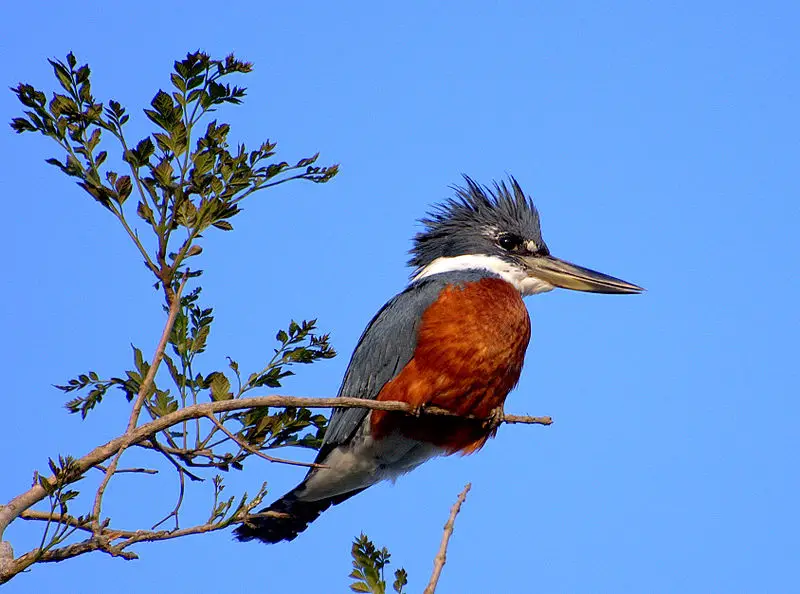
The Ringed Kingfisher is a large, vibrant bird that can be easily noticed by its loud call. It’s found in tropical regions from the lower Rio Grande Valley of southeastern Texas to Central America and even as far south as Tierra del Fuego.
This ground-dwelling species prefers to inhabit open areas near water bodies like streams, rivers and lakes which provide them with plenty of food such as fish, amphibians, crustaceans and insects.
In 1888 it was first identified by ornithologist Frank Chapman who noted its distinct ring pattern on the breast area.
The upperparts are dark blue while underneath they have white spots around their neck and belly region along with pale brown wings tipped in black stripes making this species quite unique among other kingfishers.
They may look intimidating but these birds actually play an important role for humans since they help control insect populations thus helping maintain a healthy balance within our ecosystems.Scientific classification:
| Kingdom | Animalia |
| Phylum | Chordata |
| Class | Aves |
| Order | Coraciiformes |
| Family | Alcedinidae |
| Subfamily | Cerylinae |
| Genus | Megaceryle |
| Species | M. torquata |
Also Featured In: Common Birds in Colombia, Birds that Live in Guyana
8. Groove-Billed Ani
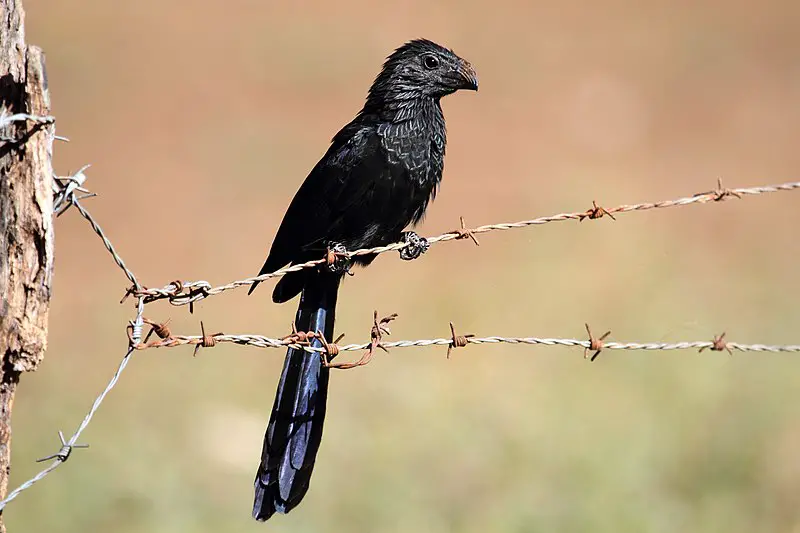
The Groove-billed ani is a tropical bird belonging to the cuckoo family. It has a long tail and large, curved beak.
This species can be found in many parts of Central America, from southern Texas to northern Colombia and Venezuela, as well as coastal Ecuador and Peru.
In some places it may retreat during colder months but overall they are considered resident birds throughout their range.
They prefer open woodlands near water sources like mangroves or swamps where there plenty of insects for them to feed on such as grasshoppers and beetles.
The beautiful coloration of this species ranges from blackish brown with orange spots on its wings that give way to bright blue feathers at the end of its tail making it quite striking.Scientific classification:
| Kingdom | Animalia |
| Phylum | Chordata |
| Class | Aves |
| Order | Cuculiformes |
| Family | Cuculidae |
| Genus | Crotophaga |
| Species | C. sulcirostris |
Also Featured In: Most Unique Birds in Peru, Most Common Birds Found in Nayarit
9. Green Kingfisher
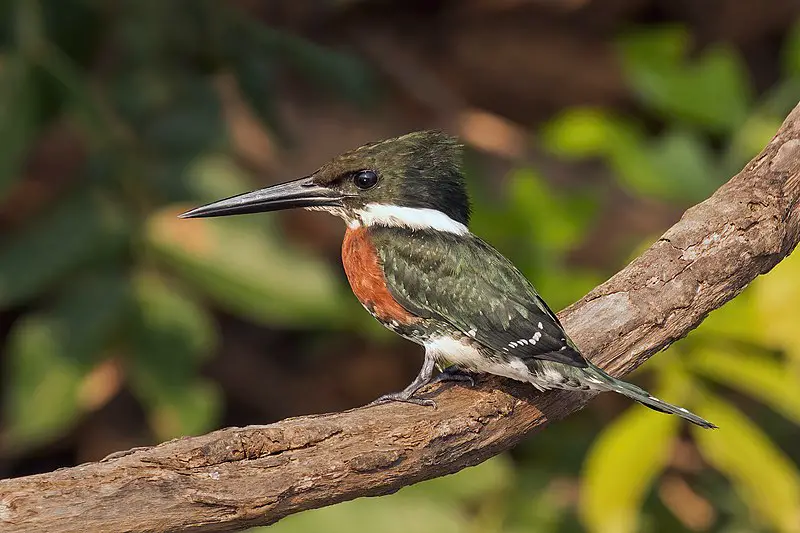
The Green Kingfisher is an incredibly vibrant bird, boasting a bright green plumage and long beak.
It can primarily be found throughout Central America, in most South American countries except Chile, as well as Texas in the United States and Trinidad & Tobago.
This species of water kingfisher belongs to subfamily Cerylinaeof family Alcedinidae which was first described by German naturalist Johann Friedrich Gmeiner back in 1788.
The Green Kingfishers are known for their active hunting habits where they perch above shallow waters looking out for prey such as small fish or crustaceans before diving down rapidly into the water with a loud splash.Scientific classification:
| Kingdom | Animalia |
| Phylum | Chordata |
| Class | Aves |
| Order | Coraciiformes |
| Family | Alcedinidae |
| Subfamily | Cerylinae |
| Genus | Chloroceryle |
| Species | C. americana |
Also Featured In: Most Common Birds Found in Chile, Green Birds in That Live in Texas
10. Buff-Bellied Hummingbird
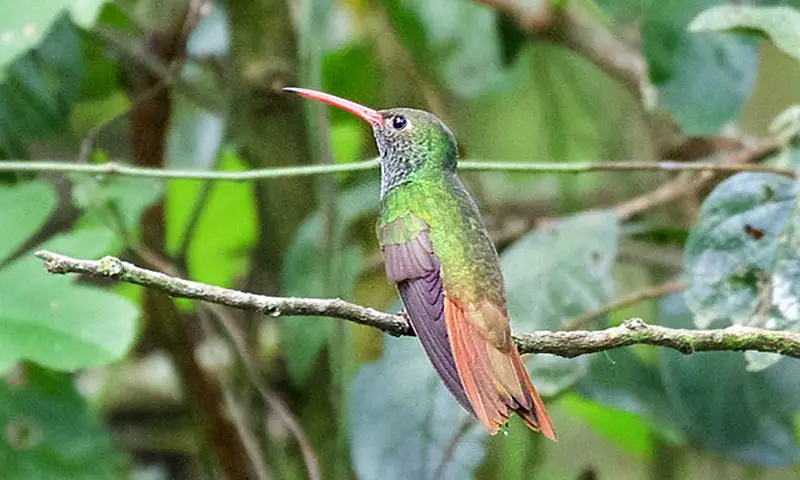
The Buff-bellied Hummingbird is a species of hummingbird belonging to the Trochilini tribe and found in Central America and parts of the United States.
It has three subspecies: A. y. yucatanensis, A. y chalconota, and A.y cerviniventris whose length ranges from 3.9 – 4 inches (10 – 11 cm).
The buff-bellied hummingbird’s plumage is mainly grey with greenish reflections on its back while it sports a distinctive buff colored belly which gives this species its name.
Its diet consists mostly of nectar as well as small insects; they often feed upon flowers near rivers or other bodies of water where their preferred food sources are plentiful.
In addition to being quite beautiful birds, these delightful creatures also possess an impressive ability for hovering flight making them one of nature’s most graceful avian wonders.Scientific classification:
| Kingdom | Animalia |
| Phylum | Chordata |
| Class | Aves |
| Order | Apodiformes |
| Family | Trochilidae |
| Genus | Amazilia |
| Species | A. yucatanensis |
Also Featured In: Most Beautiful Birds in Guatemala, Red Birds of North Carolina
11. Red-Lored Amazon
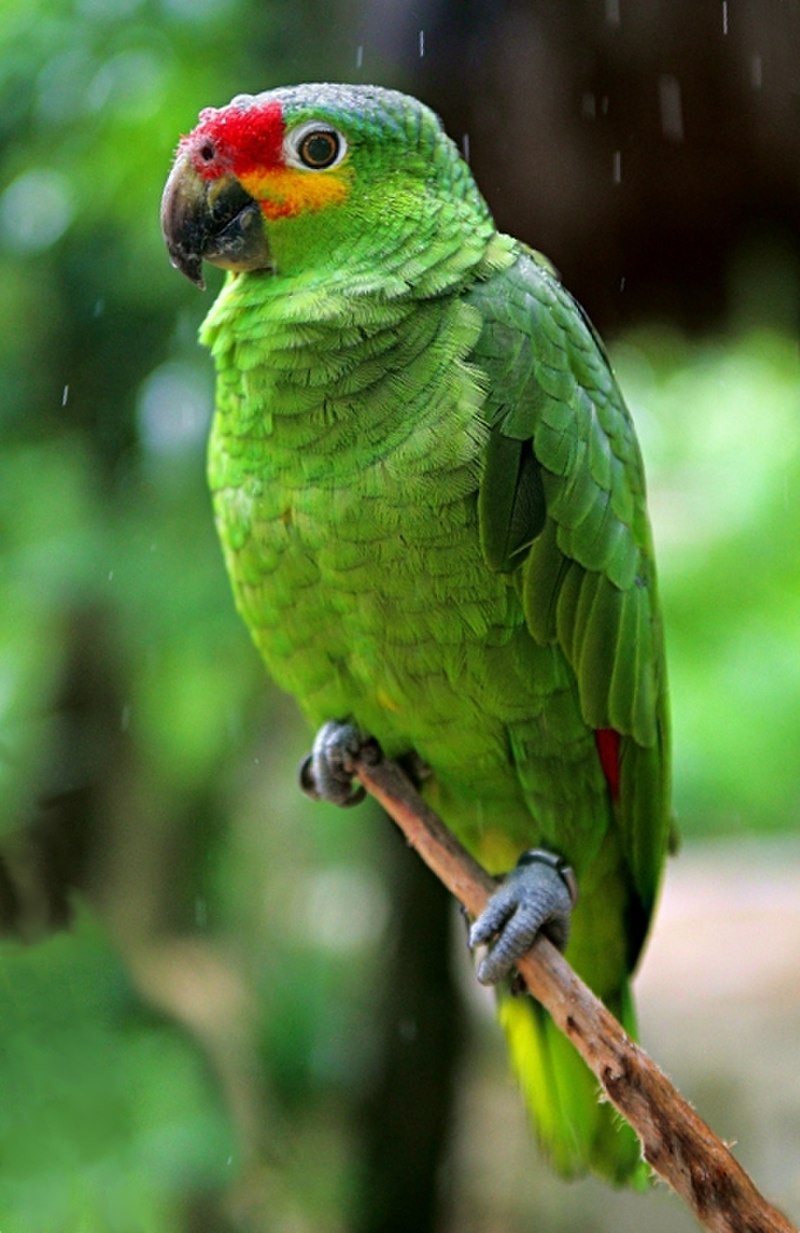
The Red-lored Amazon is a brightly coloured parrot native to tropical regions of the Americas, from eastern Mexico south to Ecuador. It inhabits humid evergreen and semi-deciduous forests up to 1,100 metres above sea level.
This species was not originally known in El Salvador but there have been reports of escaped birds seen in this region recently.
The Red-lored Amazon has an overall green plumage with red on its forehead that extends down onto its cheeks and throat while its belly is yellowish or orangey in colouration.
They are also well known for their intelligence and ability to mimic human speech which make them popular as pets.
However, they are listed under CITES Appendix II due largely because deforestation continues at an alarming rate throughout much of their range within Central America causing population declines across many areas where these birds occur naturallyScientific classification:
| Kingdom | Animalia |
| Phylum | Chordata |
| Class | Aves |
| Order | Psittaciformes |
| Family | Psittacidae |
| Genus | Amazona |
| Species | A. autumnalis |
Also Featured In: Birds of Ecuador,
12. Hook-Billed Kite
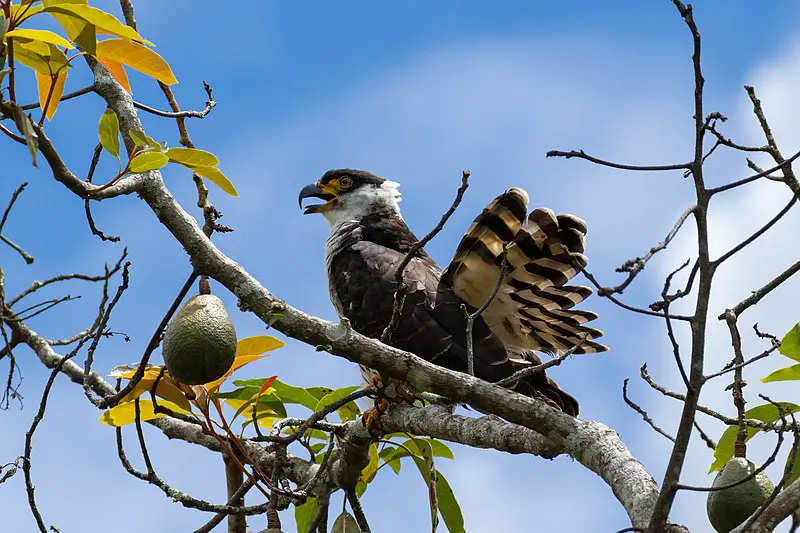
The Hook-billed Kite is a mid-sized raptor native to the Americas. It has an unmistakable striped beak and slender body, which make it easily recognizable as a member of the Accipitridae family.
This species can be found in many places from Texas in the United States all throughout Central America and tropical South America. They are also very common in Mexico, especially around the Rio Grande Valley area.
The Hook-billed Kite feeds on small reptiles such as lizards or snakes along with other insects like dragonflies or grasshoppers that they spot while soaring through their habitats near wetlands and riversides throughout its range.
Its bright colors help them blend into their surroundings making them difficult for predators to spot them when perched up high among tree branches looking out for prey below.Scientific classification:
| Kingdom | Animalia |
| Phylum | Chordata |
| Class | Aves |
| Order | Accipitriformes |
| Family | Accipitridae |
| Genus | Chondrohierax |
| Species | C. uncinatus |
Also Featured In: Most Common Types of Birds Found in Cuba,
13. Great Kiskadee
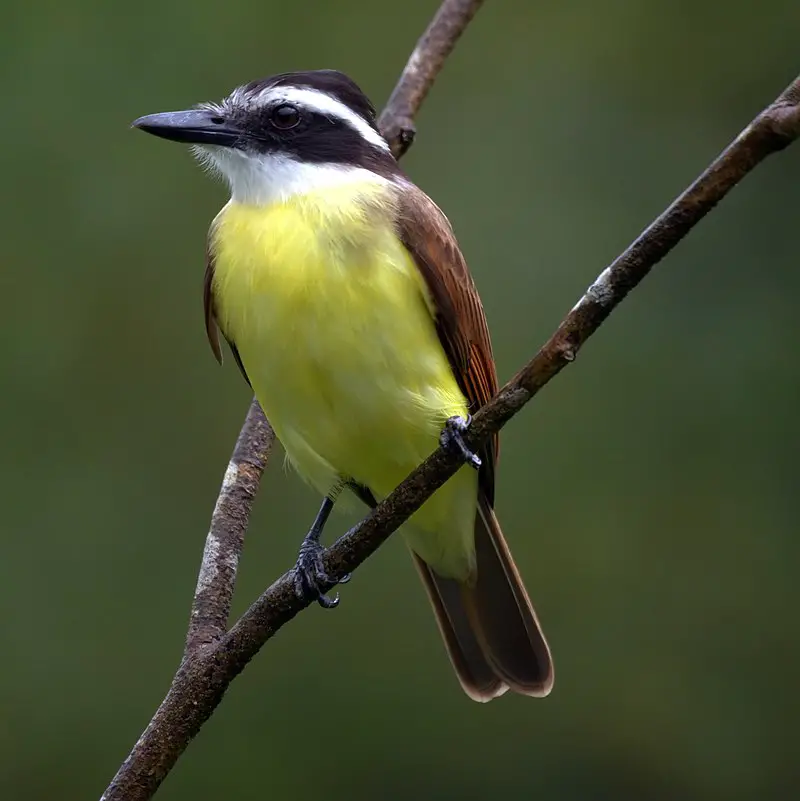
The Great Kiskadee is a passerine bird belonging to the Tyrant Flycatcher family.
It has an unmistakable yellow and black plumage, making it easily recognizable in its native habitats of Belize, Texas, Argentina and Brazil where it is known as Bem-te-vi or Benteveo respectively.
The species inhabits open woodland with some tall trees such as cultivation areas and other places surrounding human dwellings.
This adaptable bird feeds mainly on insects but also consumes fruit for energy when needed.
Its call resembles laughter which adds to its charm among avid nature watchers who are always delighted by their presence.
A unique feature that sets this species apart from others is that they can imitate songs of other birds accurately too.Scientific classification:
| Kingdom | Animalia |
| Phylum | Chordata |
| Class | Aves |
| Order | Passeriformes |
| Family | Tyrannidae |
| Genus | Pitangus Swainson, 1827 |
| Species | P. sulphuratus |
Also Featured In: Most Common Birds In Paraguay, Most Common Birds in South America Birds
14. Black-Bellied Whistling Duck
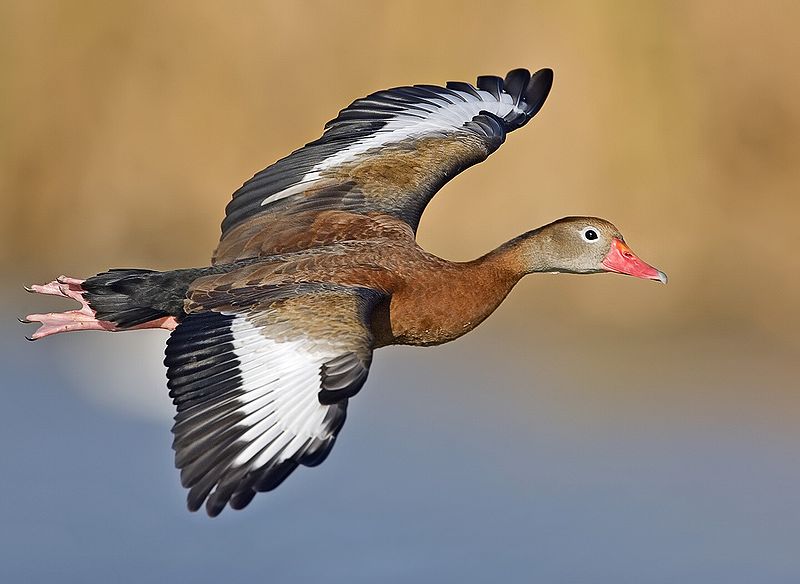
The Black-bellied whistling duck is a unique species of bird that can be found in the southern United States, Mexico, Central and South America. This small waterfowl has distinct black plumage on its belly which gives it its name.
Its call is also distinctive as it makes high pitched whistles to communicate with other members of its flock.
It prefers wetland habitats such as marshes, ponds and lakes where they feed on seeds and aquatic plants like wild rice or pondweed.
During breeding season these birds form monogamous pairs nesting in trees near bodies of water.
They are migratory birds but some may remain year round depending upon local climate conditions making them relatively common sights in certain areas during winter months when most other ducks have migrated further south for warmer weather.Scientific classification:
| Kingdom | Animalia |
| Phylum | Chordata |
| Class | Aves |
| Order | Anseriformes |
| Family | Anatidae |
| Genus | Dendrocygna |
| Species | D. autumnalis |
Also Featured In: El Salvador Birds, Birds that Live around Central Florida
15. Golden-Fronted Woodpecker
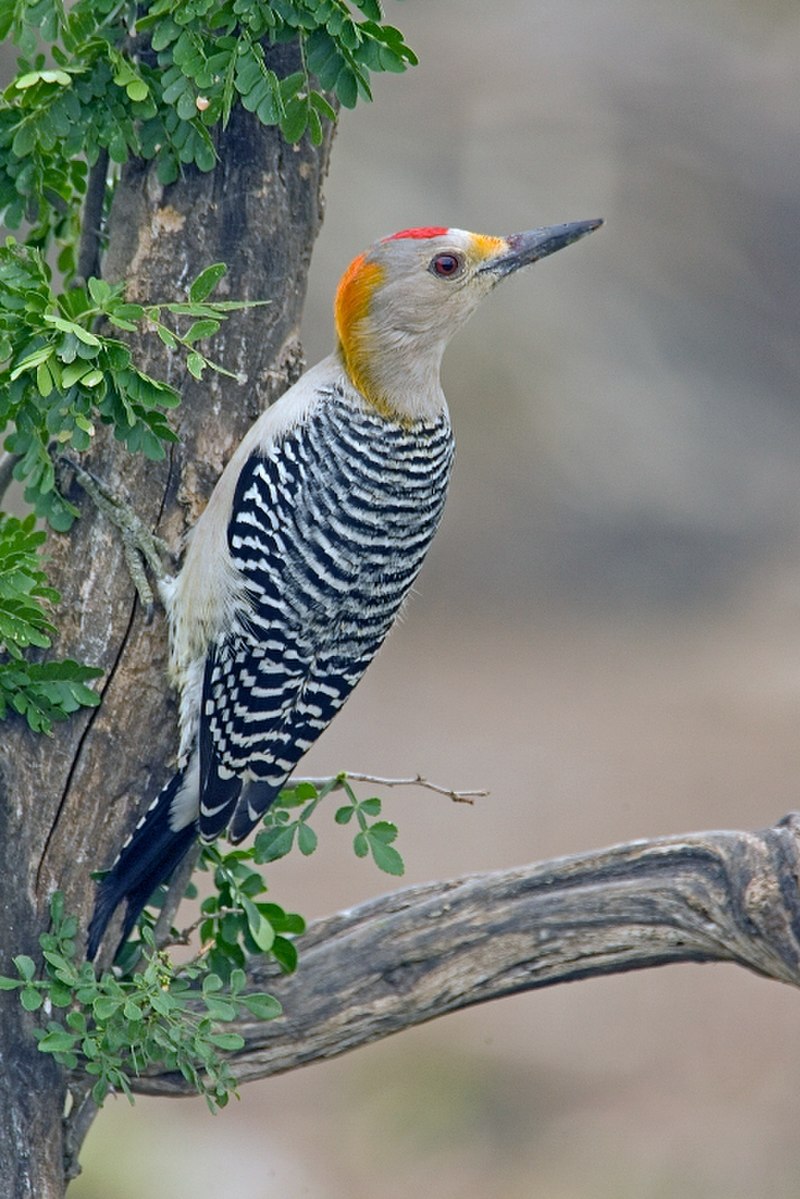
The golden-fronted woodpecker is an attractive species that inhabits mesquite, riparian woodlands and tropical rainforests across the southern United States, Mexico, Belize Guatemala El Salvador Honduras and northern Nicaragua.
It has a unique appearance with its yellow forehead patch contrasting against its grey back feathers.
These birds eat insects as well as fruits of many trees including cactus fruit in some areas.
They are known to make nests in cavities they excavate from dead or dying trees or utility poles which helps disperse essential nutrients into the ecosystem.
Their loud calls can be heard during breeding season providing bird watchers with a memorable experience.Scientific classification:
| Kingdom | Animalia |
| Phylum | Chordata |
| Class | Aves |
| Order | Piciformes |
| Family | Picidae |
| Genus | Melanerpes |
| Species | M. aurifrons |
Also Featured In: Belly Birds of Texas You Need to See,
16. Altamira Oriole

The Altamira oriole is a New World species found in subtropical lowlands from the Mexican Gulf Coast to northern Central America, and inland as well. It was only recently spotted in southern Texas since 1939.
This bird stands out among its genus for being the largest at 25cm (9.8in) and 56g (2oz). Its preferred habitat is open woodland where it builds nests made of plant fibers and animal hair lined with grasses or mosses.
Adults have black heads, wings and tails while their chests are orange-yellow with white markings on each side; juveniles display more yellowish plumage than adults do.
They feed mainly on insects but also occasionally eat fruits or nectar depending on what’s available during certain seasonsScientific classification:
| Kingdom | Animalia |
| Phylum | Chordata |
| Class | Aves |
| Order | Passeriformes |
| Family | Icteridae |
| Genus | Icterus |
| Species | I. gularis |
Also Featured In: Yellow Birds that Live in Yucatan,
17. Clay-Colored Thrush
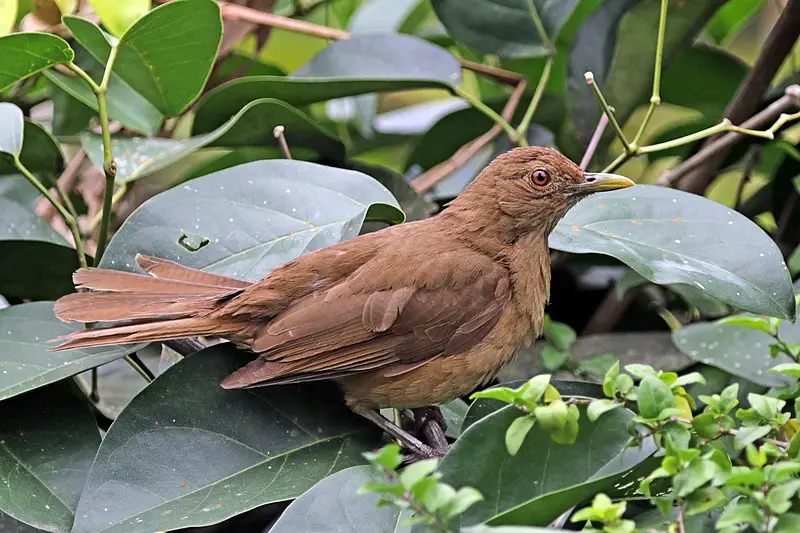
The Clay-colored Thrush is a common Middle American bird belonging to the thrush family. It has become known as Costa Rica’s national bird, going by the name yigüirro in Spanish.
Not only does it inhabit South Texas and parts of northern Colombia, but its range extends westward and northward from Isthmus Tehuantepec too.
It has an overall buffy coloration with brownish upperparts which help distinguish this species from other birds within its habitat.
Additionally, some individuals have white tips on their tail feathers that further serve to differentiate them amongst others of their kind.
This hardy species continues to thrive in many different habitats across Central America making it one of the most widespread songbirds around.Scientific classification:
| Kingdom | Animalia |
| Phylum | Chordata |
| Class | Aves |
| Order | Passeriformes |
| Family | Turdidae |
| Genus | Turdus |
| Species | T. grayi |
Also Featured In: Costa Rica Birds, Common Latin America Birds
18. Ruby-Crowned Kinglet
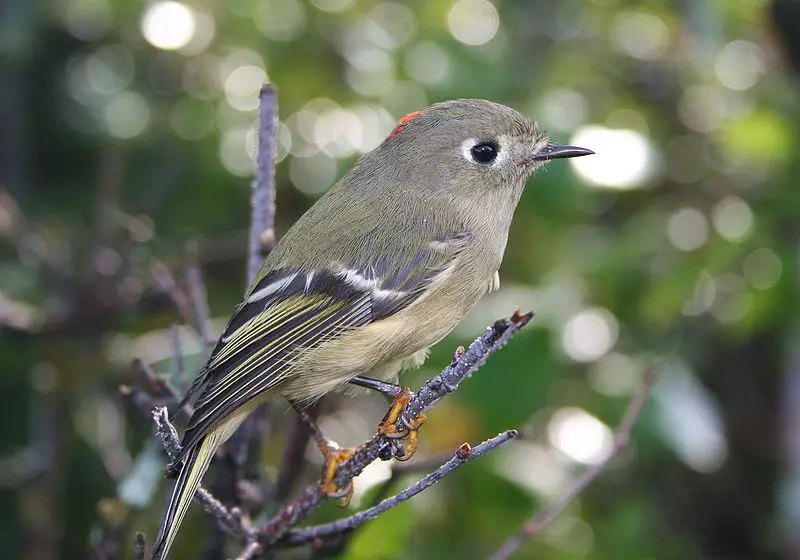
The Ruby-crowned Kinglet is a small passerine bird native to North America. It has olive green plumage, white wing bars and an eye-ring as well as a distinctive red crown patch on the males.
Juveniles look similar to adults with no distinguishing features other than size.
They are usually found in coniferous forests or woodlands where they spend much of their time searching for insects among foliage and branches while constantly flitting from place to place.
These birds have incredible energy levels that allow them to travel long distances during migration season without getting exhausted too quickly, making them one of nature’s most resilient species.Scientific classification:
| Kingdom | Animalia |
| Phylum | Chordata |
| Class | Aves |
| Order | Passeriformes |
| Family | Regulidae |
| Genus | Corthylio Cabanis, 1853 |
| Species | C. calendula |
Also Featured In: Georgia Birds, Autumn Birds You Should Know
19. Green Jay
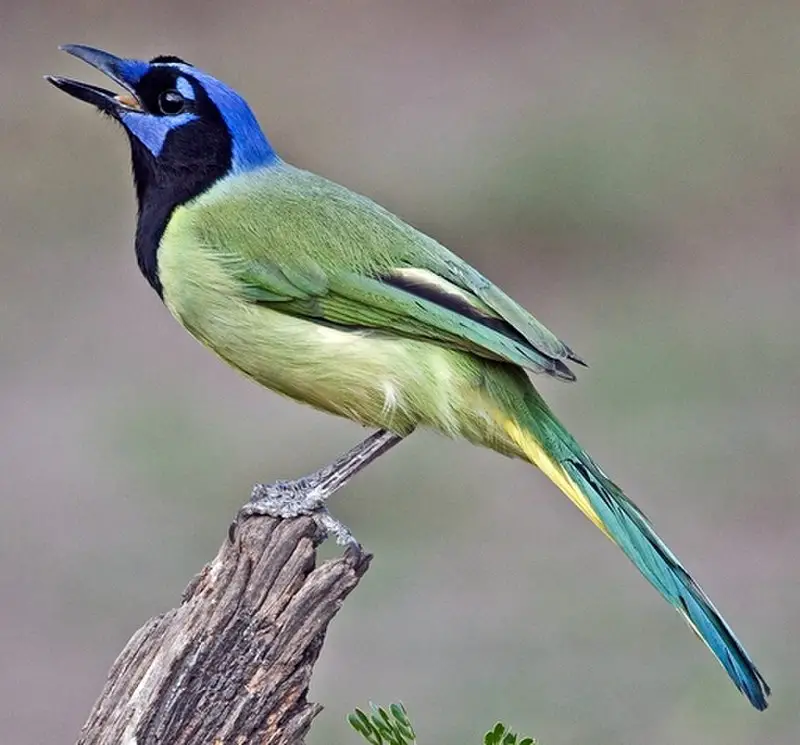
The green jay is a beautiful bird that can be found in Central America. It has blue and black heads, with green wings, mantle and tail. The bill is black while the eye rings are yellow or brown.
Its legs are dark coloured and it measures 27 cm in length. Their diet consists of arthropods, vertebrates, seeds and fruit which provide them with essential nutrients for their survival.
They have adapted to many different habitats like forests, fields and gardens where they live peacefully alongside other birds species until humans interfere with their environment by cutting down trees or polluting water sources amongst others activities that disrupts nature’s balance thus affecting these amazing creatures negatively.Scientific classification:
| Kingdom | Animalia |
| Phylum | Chordata |
| Class | Aves |
| Order | Passeriformes |
| Family | Corvidae |
| Genus | Cyanocorax |
| Species | C. luxuosus |
Also Featured In: Belize Birds,
20. Common Ground Dove
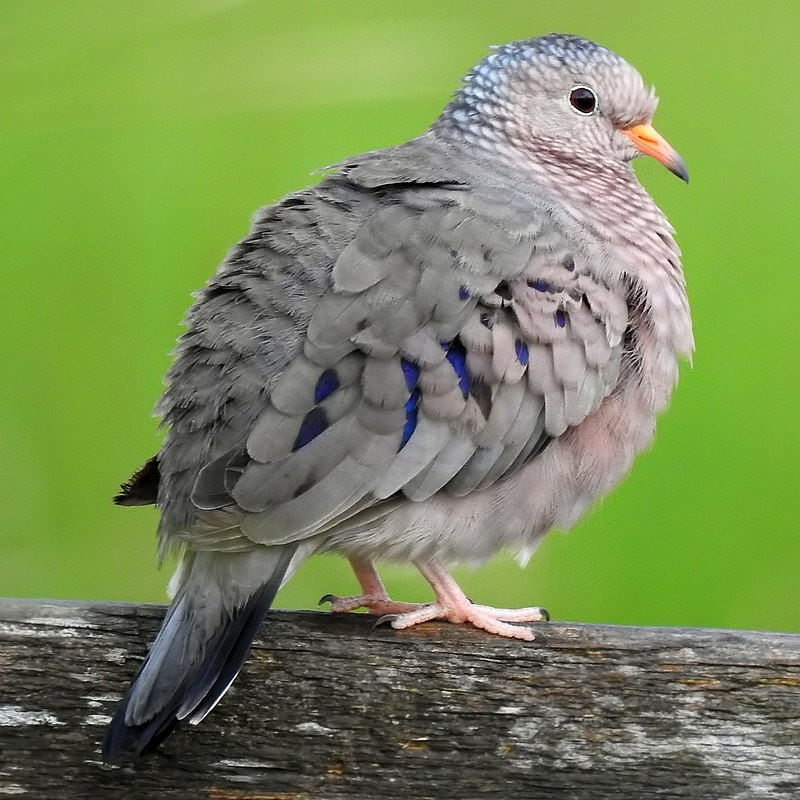
The Common Ground Dove is a small bird that can be found in the southern United States, Central America, the Caribbean and northern South America.
It’s considered to be one of the smallest dove species in North American with an average length of around 6–7 inches.
This ground-dwelling species spends most of its time on foot but has been known to fly when necessary or threatened.
The plumage is pale grayish brown above while their bellies are white and speckled with black spots along their wings.
Its diet consists mainly of seeds from grasses and other low vegetation which it forages for by walking slowly across open fields or lawns looking for food items like berries, grains, insects, spiders and snails.Scientific classification:
| Kingdom | Animalia |
| Phylum | Chordata |
| Class | Aves |
| Order | Columbiformes |
| Family | Columbidae |
| Genus | Columbina |
| Species | C. passerina |
Also Featured In: Barbados Birds, Caribbean Birds
21. Clapper Rail
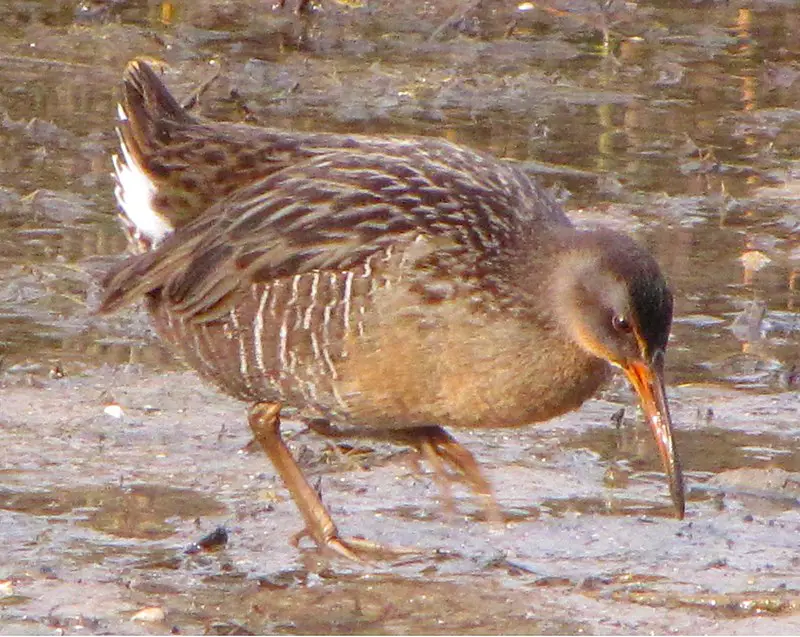
The Clapper Rail is a large, brown bird that belongs to the Rallidae family. It is found in wetlands along the eastern coast of America, Mexico and some Caribbean Islands.
This species was once considered to be related to Mangrove Rails but recent taxonomic studies have shown otherwise.
They are quite vocal with their loud calls which sound like someone clapping two stones together hence its name ‘Clapper’.
These birds feed on small crabs, fishes and insects in coastal marshes and swamps making them an important part of wetland ecosystems.
In order for these birds to thrive actions should be taken by governments such as restoring habitats or creating new ones so they can carry out their activities without any disturbance from humans or predators.Scientific classification:
| Kingdom | Animalia |
| Phylum | Chordata |
| Class | Aves |
| Order | Gruiformes |
| Family | Rallidae |
| Genus | Rallus |
| Species | R. crepitans |
Also Featured In: Saint Kitts & Nevis birds, Long Island Birds You Should Know
22. Black-Crested Titmouse
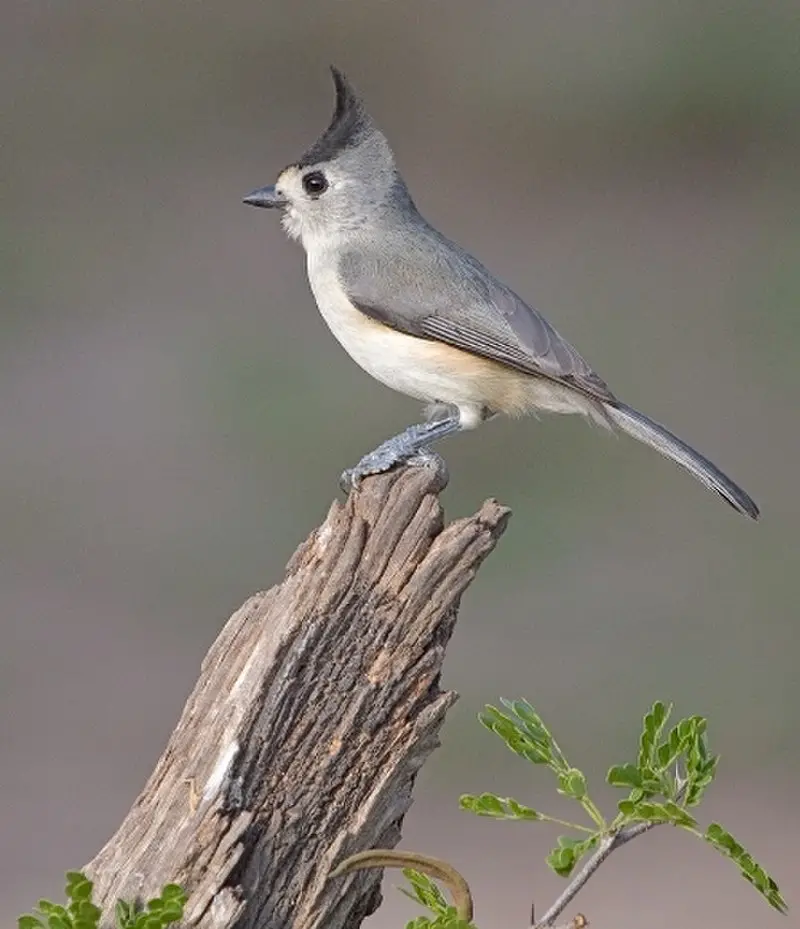
The Black-crested titmouse is a passerine bird in the Paridae family and was recently recognised as its own species.
Native to southern Texas, Oklahoma and east central Mexico, they have been known to make their way as far north and east as St. Louis Missouri through vagrancy.
The birds measure between 5 – 6 inches long with an overall grey colouring featuring white underparts and black crowns on their heads giving them the name ‘Black-crested’.
These birds are omnivores foraging for insects, fruit or seeds depending on seasonality of food sources available at different times throughout the year.
They form monogamous pairs typically making nests of twigs lined with grasses & feathers which both parents take part in building & raising young before fledging.Scientific classification:
| Kingdom | Animalia |
| Phylum | Chordata |
| Class | Aves |
| Order | Passeriformes |
| Family | Paridae |
| Genus | Baeolophus |
| Species | B. atricristatus |
Also Featured In: Chickadees Birds, Central Texas Birds
23. White-Tipped Dove
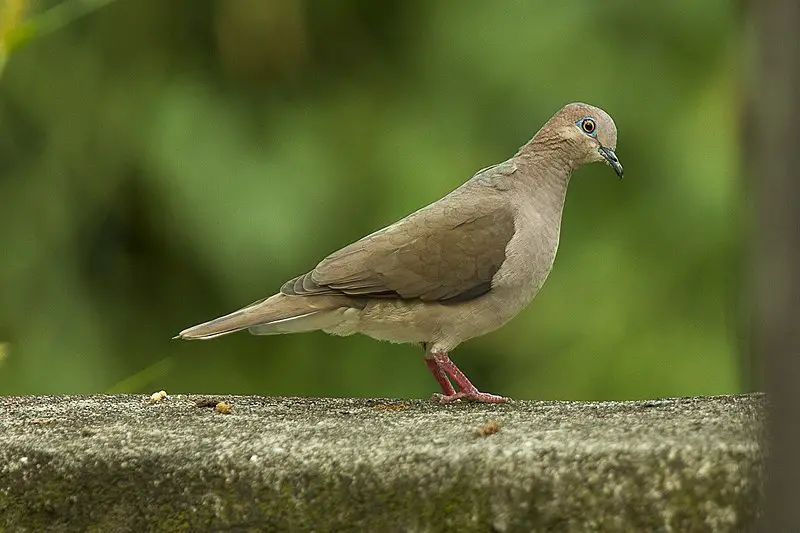
The White-tipped Dove is a majestic bird found in tropical areas of the New World, from southern Texas and Mexico all the way to western Peru and Argentina.
It carries with it an interesting scientific name: Leptotila verreauxi, named after French naturalists Jules and Edouard Verraux.
This species also breeds on offshore islands along northern South America, including Trinidad.
It has distinctive white tips on its wings which makes them easily identifiable while they are flying as well as when perched.
They have grayish brown feathers overall that helps camouflage them amongst trees or foliage making them difficult to spot otherwise.
The males tend to be slightly larger than females but other than that there isn’t much difference between their appearance aside from courtship rituals where both sexes will bow together for recognition before mating season starts.Scientific classification:
| Kingdom | Animalia |
| Phylum | Chordata |
| Class | Aves |
| Order | Columbiformes |
| Family | Columbidae |
| Genus | Leptotila |
| Species | L. verreauxi |
Also Featured In: Doves Birds, Birds You’ll Find in South Texas
24. Scissor-Tailed Flycatcher
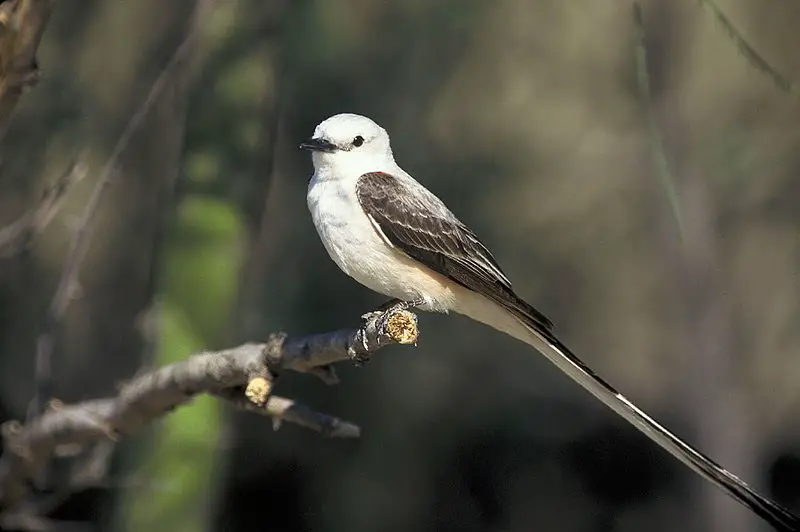
The scissor-tailed flycatcher is a beautiful bird, belonging to the Tyrannus genus of kingbirds. It is known by various names such as Texas Bird-of Paradise and Swallow-tailed Flycatcher.
This insectivorous bird has an impressive long tail which it uses for courtship displays and aerial acrobatics – making it quite the showstopper.
Its range includes North America and Central South American regions where they breed in open fields, pastures or grasslands with scattered trees available.
They feed on insects like dragonflies, damselflies and small moths that they catch while gliding through air gracefully with their wings spread apart wide.
To watch this amazing creature soar freely over its habitat would be nothing short of breathtaking.Scientific classification:
| Kingdom | Animalia |
| Phylum | Chordata |
| Class | Aves |
| Order | Passeriformes |
| Family | Tyrannidae |
| Genus | Tyrannus |
| Species | T. forficatus |
Also Featured In: Flycatchers Species, Summer Birds that Live around Us
25. Say’s Phoebe
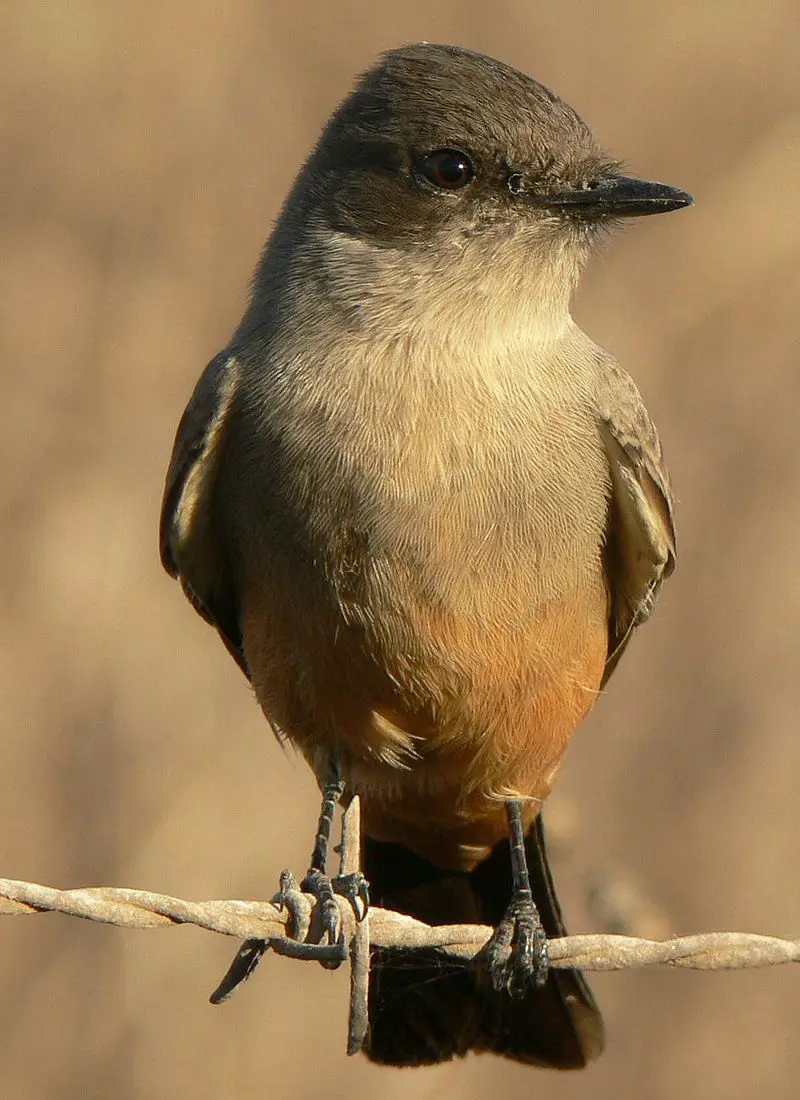
Say’s phoebe is a bird from the tyrant flycatcher family native to western North America. It was named for American naturalist Thomas Say, who first described it in 1825.
This species prefers dry and desolate areas as its habitat. Its brown plumage with whitish underside makes them quite easy to spot among other birds of similar size.
They are also known for their distinctive call; “phoe-bee” which they repeat often throughout the day while perched on fence posts or tree branches scanning their surroundings looking out for food sources such as flying insects, small frogs and lizards etc..
Their nests are made up of plant materials like grasses lined with hair or feathers placed inside cavities either under overhangs or in abandoned structures like barns and sheds providing ample protection against predators such as hawks and foxes.Scientific classification:
| Kingdom | Animalia |
| Phylum | Chordata |
| Class | Aves |
| Order | Passeriformes |
| Family | Tyrannidae |
| Genus | Sayornis |
| Species | S. saya |
Also Featured In: Phoenix Birds You Should Know, Birds that Live in Arizona Desert
26. Red-Crowned Amazon
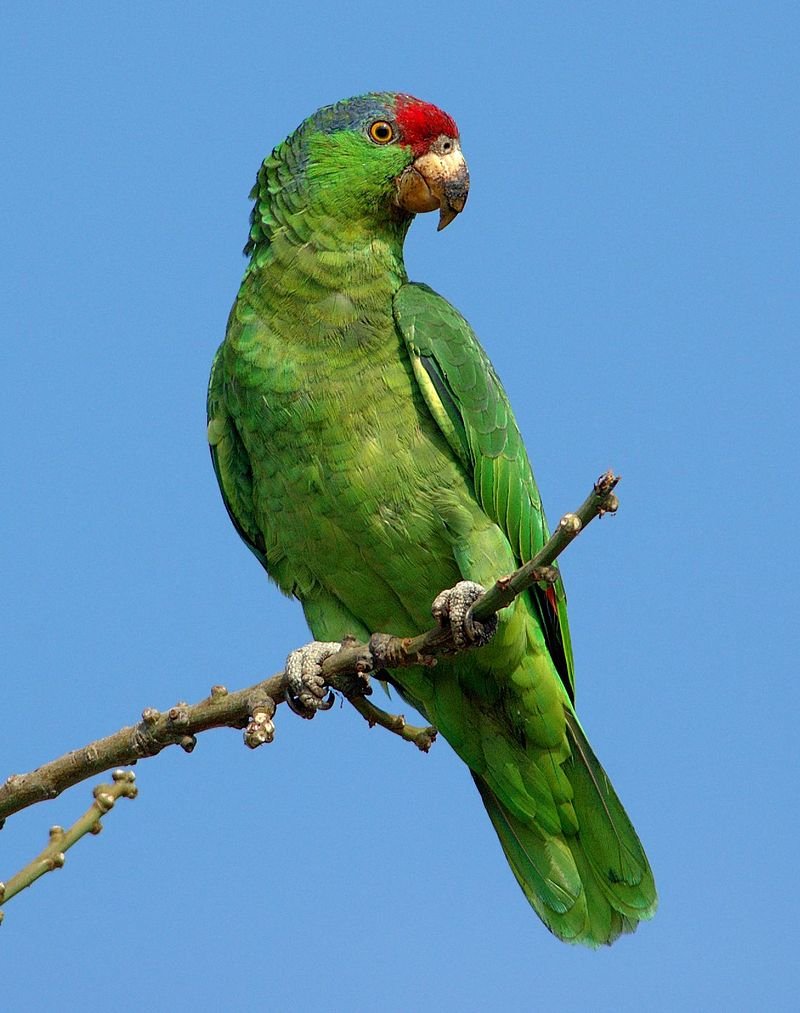
The Red-crowned Amazon is an endangered bird native to northeastern Mexico and possibly southern Texas. This parrot has a distinct red crown, green cheeks, and grayish wings with yellow highlights.
It typically lives in open woodlands near water sources such as rivers or lagoons. The estimated population of the wild stands between 2,000 – 4,300 mature individuals due to habitat destruction and illegal poaching for pet trade purposes.
Conservation efforts are being made by organizations like the IUCN Species Survival Commission Parrots Specialist Group (PSG) which works towards protecting this species from extinction through research projects along its range countries.Scientific classification:
| Kingdom | Animalia |
| Phylum | Chordata |
| Class | Aves |
| Order | Psittaciformes |
| Family | Psittacidae |
| Genus | Amazona |
| Species | A. viridigenalis |
Also Featured In: Parrots Species, Green Birds Commonly Found in Florida
27. Olive Sparrow
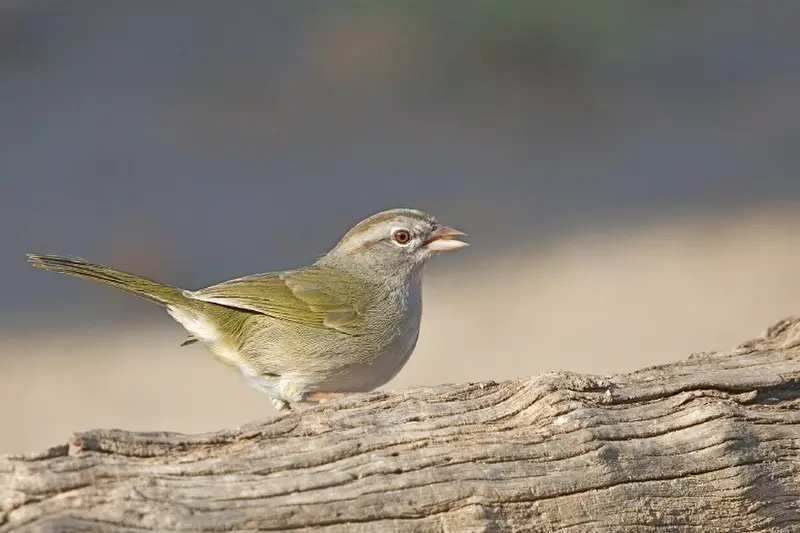
The Olive Sparrow is a species of American sparrow in the family Passerellidae. It has an olive-colored back, with white streaks on its sides and dark brown stripes above its eyes.
Its wings are also slightly darker than its body coloration. This small bird grows to be between 5.5 – 6.1 inches long and can typically be found in Belize, Costa Rica, Guatemala, Honduras Mexico Nicaragua and southern Texas (Val Verde County).
The Olive Sparrow feeds mainly on insects but will eat some seeds as well as berries when they become available during certain times of the year making them omnivores by nature.
They usually make their nests high up in trees or bushes where there’s plenty of cover from predators such as hawks or owls which may prey upon them if given the opportunity to do so.Scientific classification:
| Kingdom | Animalia |
| Phylum | Chordata |
| Class | Aves |
| Order | Passeriformes |
| Family | Passerellidae |
| Genus | Arremonops |
| Species | A. rufivirgatus |
Also Featured In: Sparrows Species, Birds That Live around South Padre Island
28. Cave Swallow
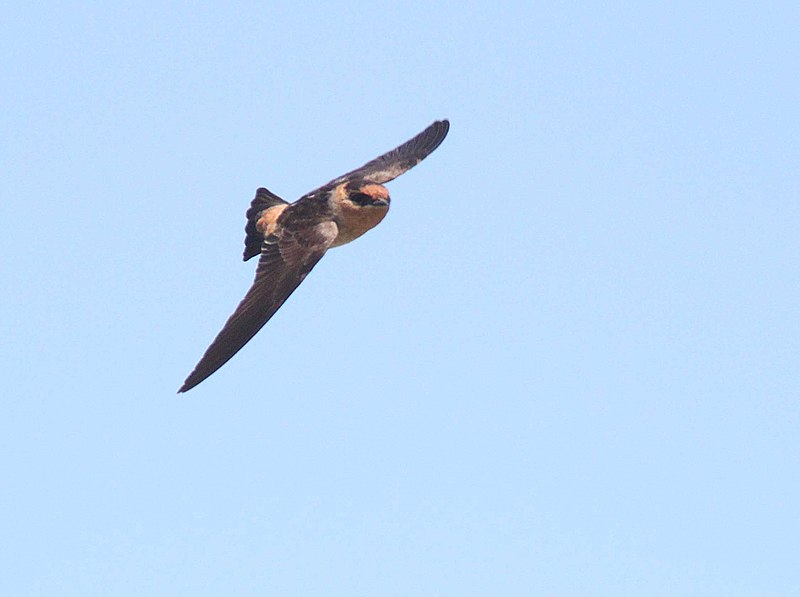
The Cave Swallow is a species of bird native to the Americas, belonging to the same genus as the more widely known Cliff Swallow.
It is medium-sized with a square tail and nests in caves and sinkholes rather than typical nesting spots like trees or buildings.
This beautiful swallow can be found in Mexico and Greater Antilles, but has been known to wander north during fall/winter months reaching east coast areas along with Gulf Coasts.
These birds are interesting due their habit of exclusively using natural cavities for protection while they breed, making them unique compared to other swallows who rely on man-made structures such as barns or bridges.
The Cave Swallow is an important part of its environment that should be preserved so future generations can appreciate its beauty.Scientific classification:
| Kingdom | Animalia |
| Phylum | Chordata |
| Class | Aves |
| Order | Passeriformes |
| Family | Hirundinidae |
| Genus | Petrochelidon |
| Species | P. fulva |
Also Featured In: Swallows Species, Birds that Make Mud Nests
29. Ladder-Backed Woodpecker
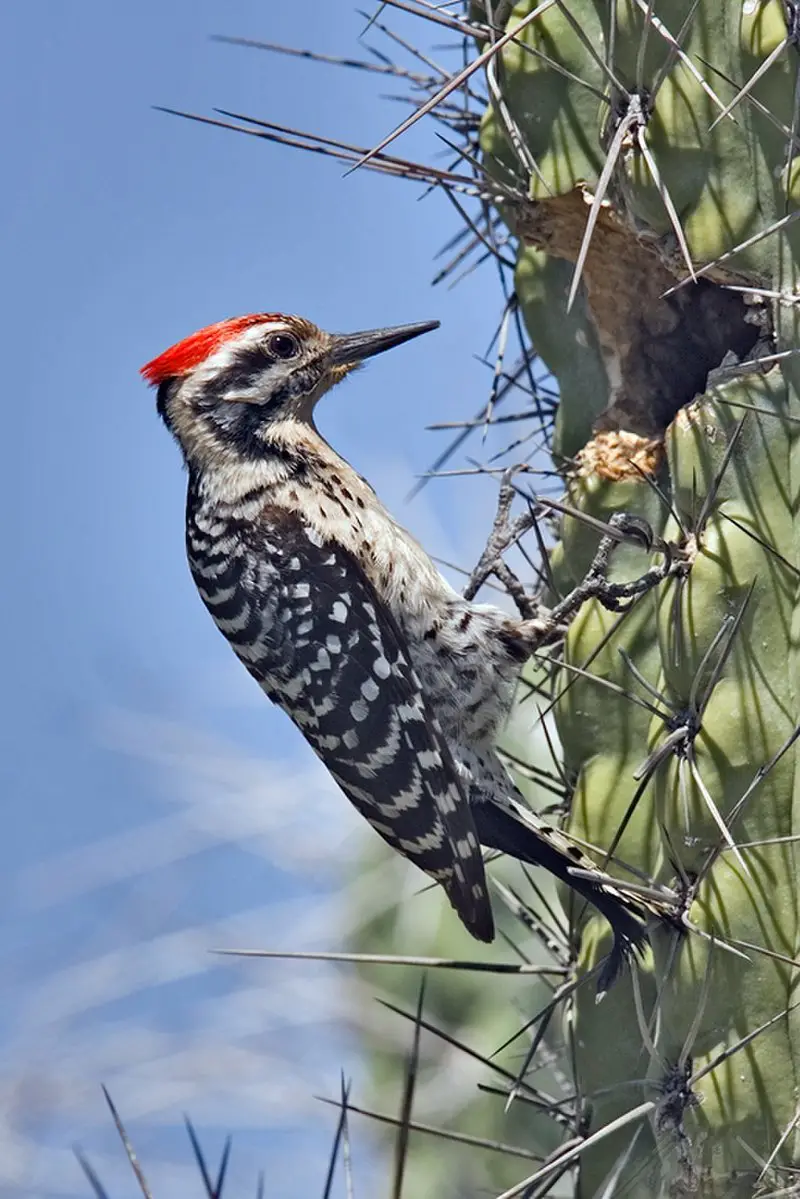
The Ladder-backed Woodpecker is a small black and white bird native to North America.
At about 16.5-19 cm in length, it has a characteristic barred pattern on its back resembling the rungs of a ladder, as well as speckled black rump and cream colored underparts on its breast and flanks.
These birds can be found inhabiting woodlands across their range, where they feed mostly on insects that they find by drilling into trees or hunting from exposed branches.
Their call consists of short chirps repeated every few seconds with an occasional longer trill thrown in for good measure.
They are also known to use twigs or other objects to probe crevices while searching for food – making them quite resourceful hunters indeed.Scientific classification:
| Kingdom | Animalia |
| Phylum | Chordata |
| Class | Aves |
| Order | Piciformes |
| Family | Picidae |
| Genus | Dryobates |
| Species | D. scalaris |
Also Featured In: Woodpeckers Species, Birds that Live in the Grand Canyon National Park
30. Painted Bunting
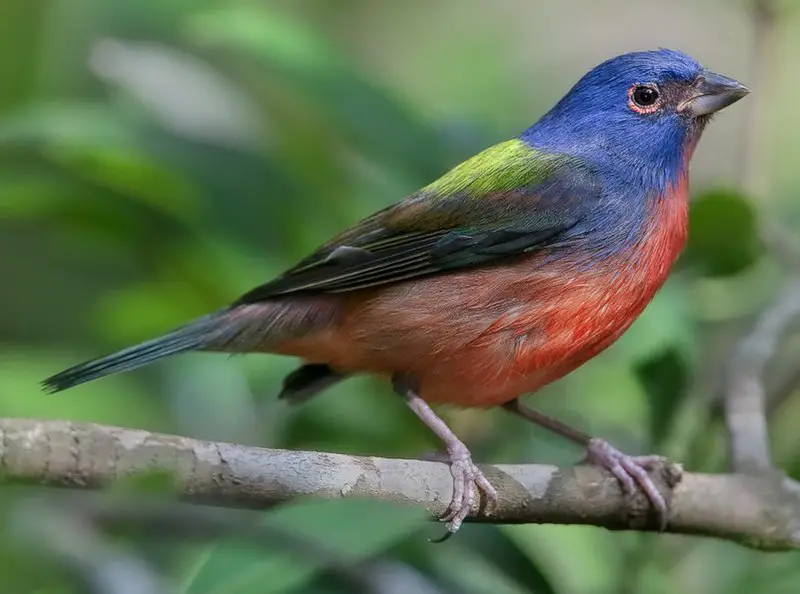
The Painted Bunting is an eye-catching bird from the Cardinal family, native to North America. It was first described by Carl Linnaeus in his eighteenth-century Systema Naturae.
The males of this species are particularly striking; they have brightly coloured plumage which only appears after their second year of life and can be distinguished from female birds through close inspection.
These colourful songbirds are a delight for any avid birder, with their vibrant hues bringing joy to nature lovers everywhere.
They often inhabit woodland areas where there is plenty of seed and insects available for them to feed on – as well as some shrubbery so that they can hide away safely when needed.Scientific classification:
| Kingdom | Animalia |
| Phylum | Chordata |
| Class | Aves |
| Order | Passeriformes |
| Family | Cardinalidae |
| Genus | Passerina |
| Species | P. ciris |
Also Featured In: Texas Birds, Flocks Birds around Us
31. Orange-Crowned Warbler
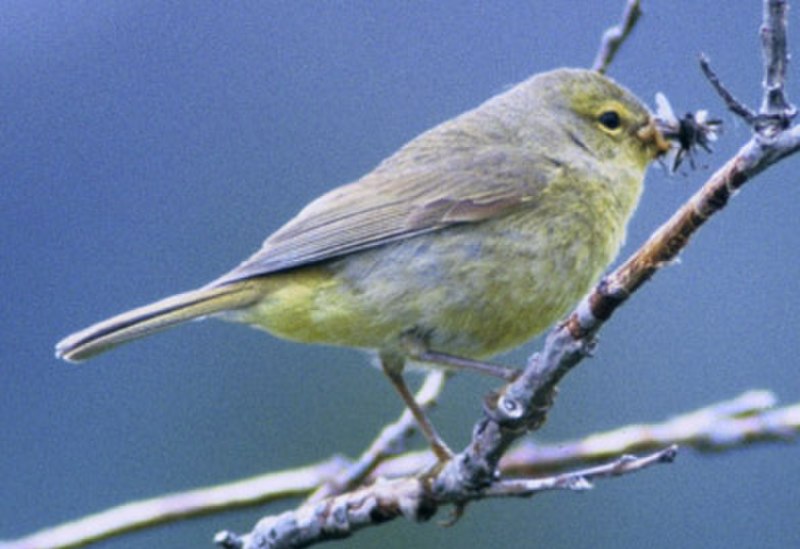
The Orange-crowned Warbler is a small songbird from the New World warbler family. It was formally described in 1822 by Thomas Say, who gave it its scientific name Sylvia celatus – Latin for ‘cloaked’.
This species has an olive green back and wings with yellowish underparts. The males have bright orange crowns during breeding season, which give this bird its namesake.
They can be found mainly in North America but they also migrate to Central America during winter months.
Their diet consists of insects such as butterflies, moths, grasshoppers and beetles; they may also consume fruits occasionally when available.
These birds are relatively quiet except for their mating calls which include whistles or buzzing sounds that last a few seconds long each time.
The Orange-crowned Warbler is one of the most wide spread passerines today due to their hardiness and adaptability; however there remains threat of habitat destruction that could affect many populations negatively if not addressed soon enough.Scientific classification:
| Kingdom | Animalia |
| Phylum | Chordata |
| Class | Aves |
| Order | Passeriformes |
| Family | Parulidae |
| Genus | Leiothlypis |
| Species | L. celata |
Also Featured In: Common Birds in Saskatchewan, Birds that Live in Mississippi
32. Curve-Billed Thrasher
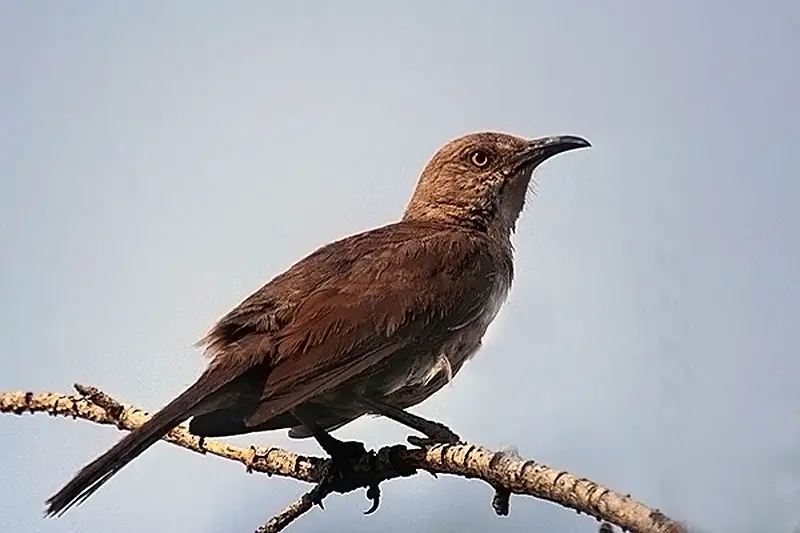
The Curve-billed Thrasher is a medium-sized bird native to Mexico and the southwestern United States. It lives mainly in desert areas, where it can be found foraging on the ground for its insect prey.
Its name comes from its curved bill, which aids in rooting out insects and other food sources.
The species has several subspecies that are geographically separated throughout much of their range; allopatric speciation likely played an important role here as well.
Despite being non-migratory, this thrasher will sometimes travel long distances when resources become scarce or during courtship displays with potential mates.
A successful predator of grasshoppers, beetles and other arthropods, the Curve-billed Thrasher plays an essential role in maintaining healthy ecosystems by controlling pest populations.Scientific classification:
| Kingdom | Animalia |
| Phylum | Chordata |
| Class | Aves |
| Order | Passeriformes |
| Family | Mimidae |
| Genus | Toxostoma |
| Species | T. curvirostre |
Also Featured In: birds of Arizona, Birds that Live in the Deserts
33. Pyrrhuloxia
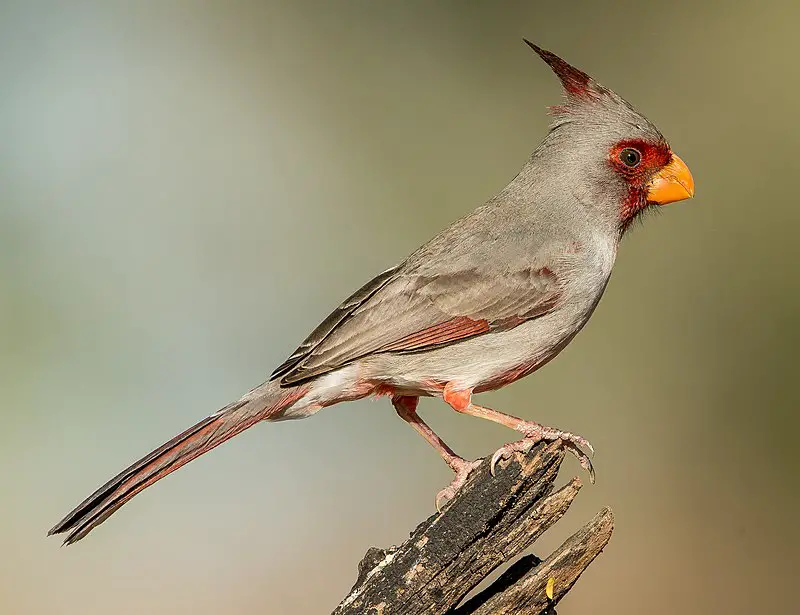
The Pyrrhuloxia, also known as the desert cardinal, is a stunningly beautiful bird native to the American Southwest and northern Mexico.
With its red crest and wings, short stout bill, it closely resembles the Northern Cardinal and Vermilion Cardinal of its same genus.
It has an average size compared to other songbirds in this area at around 18cm long with a wingspan of up to 28 cm wide.
Its diet mainly consists of small insects such as grasshoppers but they will occasionally eat some fruit or seeds too.
The Pyrrhuloxia’s singing ability rivals many birds in that region due to their clear whistles which can be heard from afar on quiet mornings.
The beauty of these birds makes them very popular among birdwatchers who come from all over just for a chance glimpse of one.Scientific classification:
| Kingdom | Animalia |
| Phylum | Chordata |
| Class | Aves |
| Order | Passeriformes |
| Family | Cardinalidae |
| Genus | Cardinalis |
| Species | C. sinuatus |
Also Featured In: Red birds You’ll See in Arizona, Red Birds You’ll See in Oklahoma
34. Long-Billed Thrasher
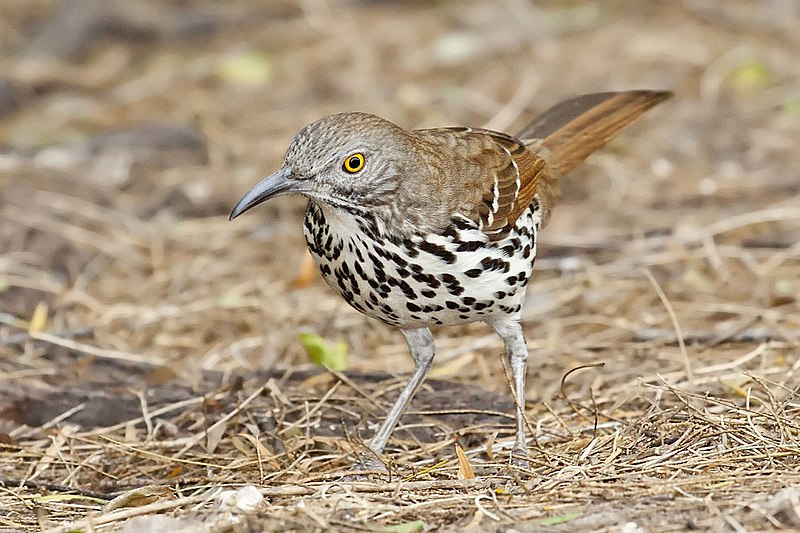
The Long-billed Thrasher is a medium-sized songbird found in South Texas and eastern Mexico.
It has similar features to the Brown Thrasher, such as its calls, appearance and behaviors; although they do not share overlapping ranges except during winter when the Brown Thrasher will reside temporarily in northern areas of where the Long-billed resides.
This species boasts an impressive long bill for probing into ground cover looking for insects, fruits and other food sources – this also serves well when singing its loud melodious songs from elevated perches.
The mottled brown plumage allows them camouflage amongst dense shrubs or trees making it harder to detect by predators.
When nesting season arrives these thrashers can become quite territorial defending their nests fiercely against intruders.Scientific classification:
| Kingdom | Animalia |
| Phylum | Chordata |
| Class | Aves |
| Order | Passeriformes |
| Family | Mimidae |
| Genus | Toxostoma |
| Species | T. longirostre |
Also Featured In: birds of brown,
35. Audubon’s Oriole
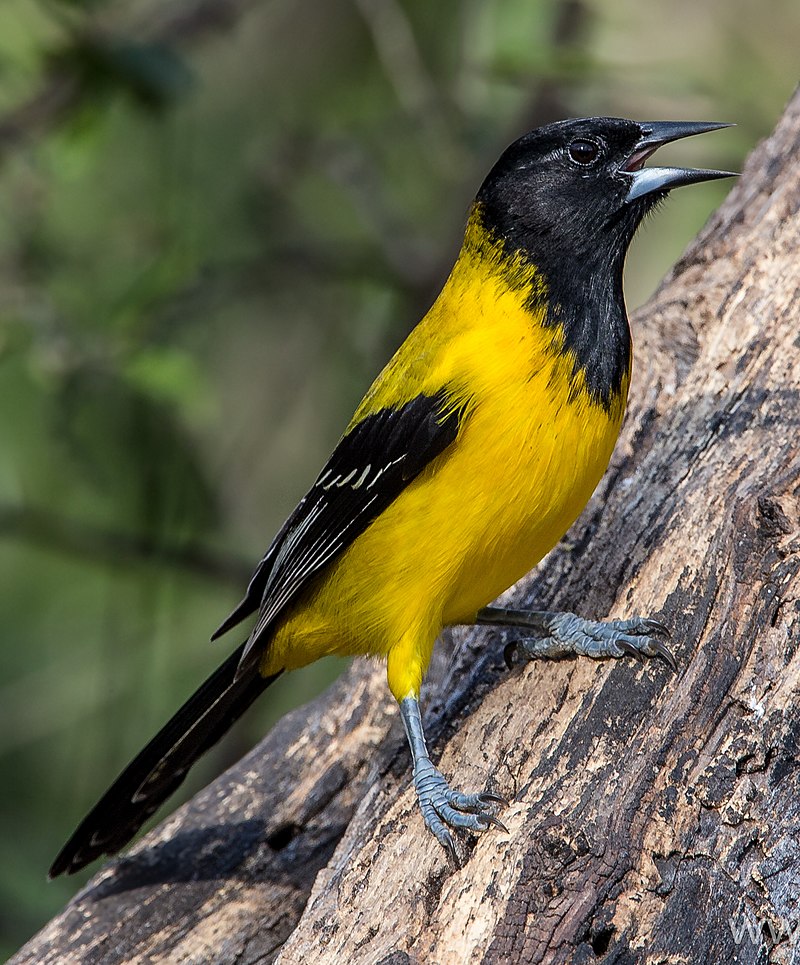
Audubon’s oriole is a beautiful bird that can be found in southeastern Texas and the Mexican coast. It has a unique appearance with a black hood and yellow body, making it distinguishable from other oriole species.
There are four subspecies of the Audubon’s oriole, each with a slightly different range. The bird inhabits forests and thickets and is commonly seen in these areas. It is the only species of oriole with a black hood and yellow body.
The bird has two allopatric breeding ranges, with the westernmost range extending from Nayarit down to southern Oaxaca.
Audubon’s oriole is a passerine, which means that it has three toes pointing forward and one pointing backward. It is a beautiful bird that is cherished by bird enthusiasts and nature lovers alike.Scientific classification:
| Kingdom | Animalia |
| Phylum | Chordata |
| Class | Aves |
| Order | Passeriformes |
| Family | Icteridae |
| Genus | Icterus |
| Species | I. graduacauda |
Also Featured In: Yellow Indiana Birds, Black Birds that Live around United States of America
36. Plain Chachalaca
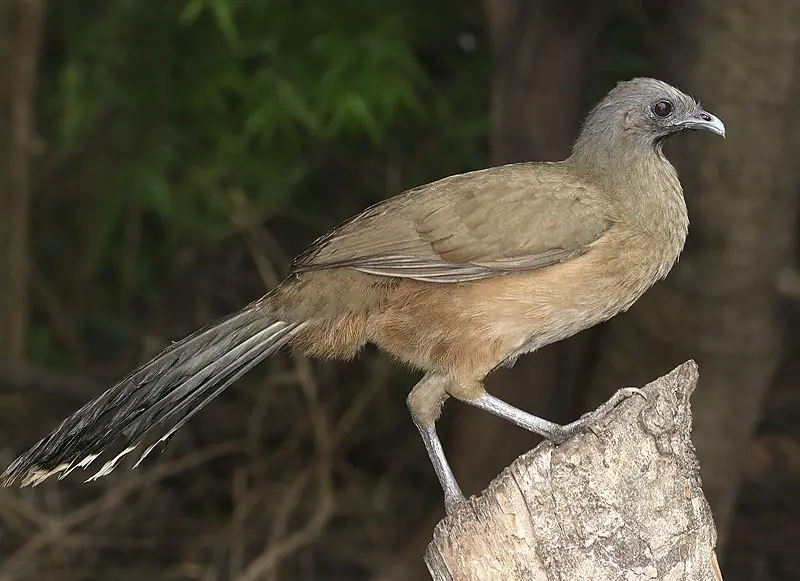
The plain chachalaca is a sizeable bird belonging to the Cracidae family, which includes guans and curassows. It can be found in tropical and subtropical regions from southernmost Texas in the US to northern Costa Rica.
This species breeds in various environments such as mezquital thickets and Pacific lowlands from Chiapas to Nicaragua.
Its distinct feature is the bare skin on its head and neck, which is bright red in color. The plain chachalaca is known for its hearty appetite and feeds primarily on fruits, seeds, and insects.
They are typically noisy birds, communicating with each other through loud vocalizations that can be heard up to one mile away.
Despite being hunted for meat in some areas, their overall population remains stable, and they are not currently considered a threatened species.Scientific classification:
| Kingdom | Animalia |
| Phylum | Chordata |
| Class | Aves |
| Order | Galliformes |
| Family | Cracidae |
| Genus | Ortalis |
| Species | O. vetula |
Also Featured In: Most Common Birds of Nuevo Leon, Birds that Live in Tabasco
37. Sora
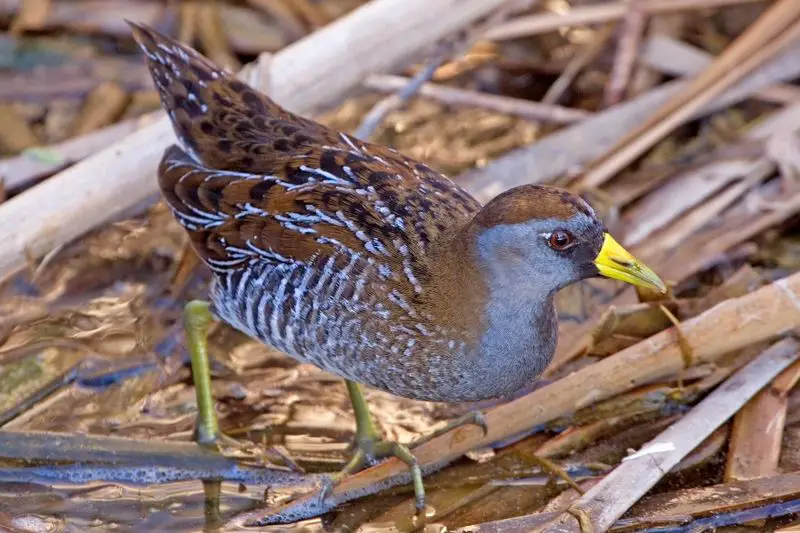
The Sora bird, a member of the rail family Rallidae, can be found throughout much of North America. Its genus name Porzana is derived from Venetian terms for small rails, while its specific name carolina refers to the Carolina Colony.
The common name “Sora” is likely taken from a Native American language. Soras are small waterbirds, sometimes called sora rails or sora crakes. These birds are characterized by their brownish-gray plumage and short, straight bills.
They can be found in marshes, wetlands, and other waterlogged areas, where they typically feed on seeds and insects.
Despite their small size, soras are migratory birds and travel long distances during their seasonal migrations.
Overall, the Sora bird is an interesting and important member of the North American avian community.Scientific classification:
| Kingdom | Animalia |
| Phylum | Chordata |
| Class | Aves |
| Order | Gruiformes |
| Family | Rallidae |
| Genus | Porzana |
| Species | P. carolina |
Also Featured In: Wetlands Birds You Should Know, Small Birds Of Illinois
38. Scaled Quail
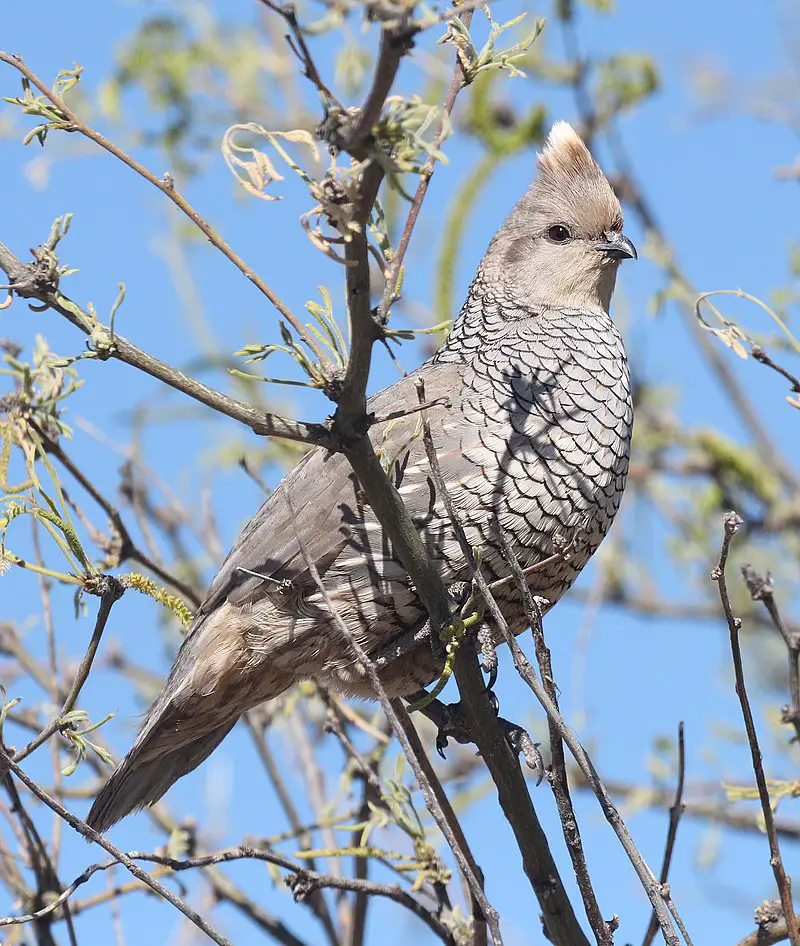
The Scaled quail bird, known as the blue quail or cottontop, is a bluish gray bird found in arid regions of the Southwestern United States to Central Mexico.
It is a member of the New World quail family and an early offshoot of the genus Callipepla that diverged in the Pliocene. The bird’s breast and back feathers have a scaly appearance, which led to its name.
This species is unique in its appearance and is a fascinating addition to the ornithological diversity in the region. Its blue-gray coloration makes it easy to distinguish from other quail species.
The Scaled quail bird is a native bird species in the southwestern United States and is well adapted to surviving in arid conditions.
Its distinct and charming qualities make it a favorite among bird enthusiasts.Scientific classification:
| Kingdom | Animalia |
| Phylum | Chordata |
| Class | Aves |
| Order | Galliformes |
| Family | Odontophoridae |
| Genus | Callipepla |
| Species | C. squamata |
Also Featured In: Birds that Live in the Grasslands,
39. Vermilion Flycatcher
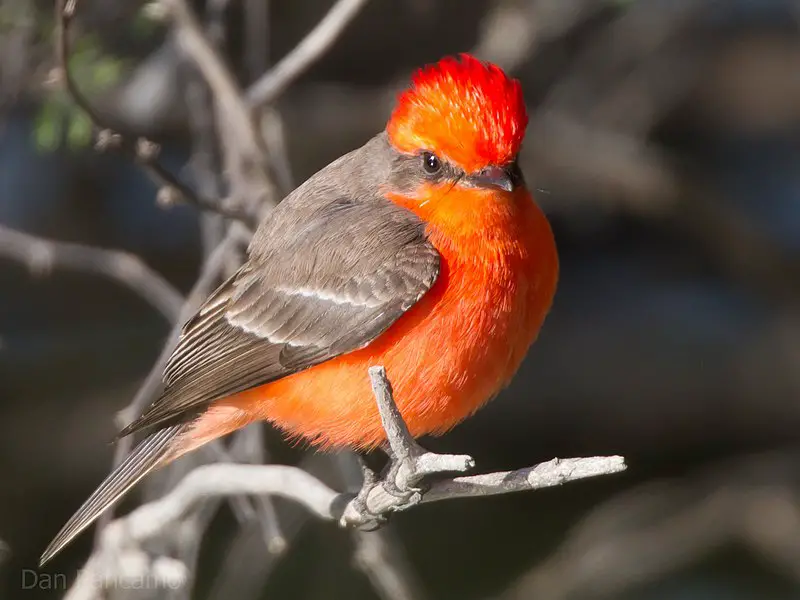
The Vermilion flycatcher is a colorful bird from the tyrant flycatcher family, typically found in South America and southern North America.
With its bright red crown, chest, and underparts, the male is a striking exception among its generally drab relatives.
The female lacks the vivid red coloration of the male, but displays earthy brown wings and tail. As a passerine bird, the Vermilion flycatcher feeds on insects by catching them in midair.
These birds are known for their distinctive “whit” calls, and can be spotted in a variety of habitats, from deserts to forests.
Their numbers appear to be stable, although local populations may be vulnerable due to habitat destruction.
Despite its small size, the Vermilion flycatcher is a memorable and distinctive addition to the avian world.Scientific classification:
| Kingdom | Animalia |
| Phylum | Chordata |
| Class | Aves |
| Order | Passeriformes |
| Family | Tyrannidae |
| Genus | Pyrocephalus |
| Species | P. obscurus |
Also Featured In: Red Birds You’ll Commonly Found in Texas, Common Red Birds of Georgia
40. Bronzed Cowbird
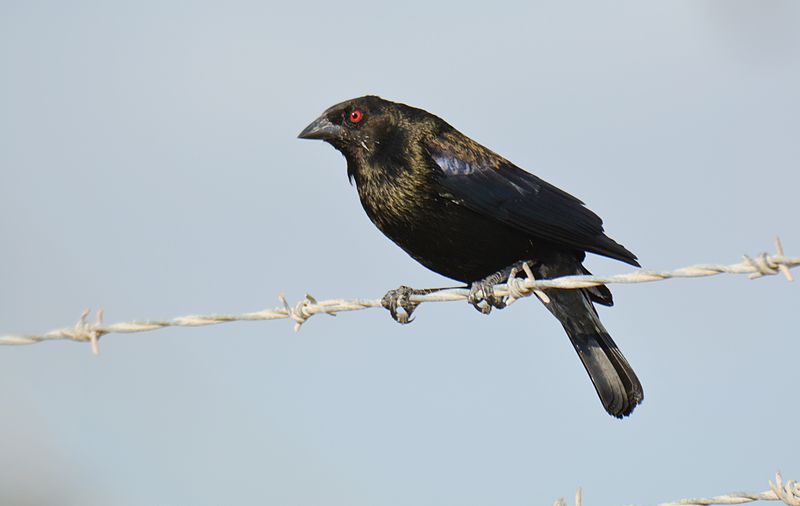
The bronzed cowbird is a small icterid species that was formerly known as the red-eyed cowbird. They are found breeding in several states of the US and many Central American countries, including Panama.
You may often spot them in farmland, brush, and feedlots, where they tend to forage. These birds prefer open habitats when not breeding and roost in dense woods.
They exhibit brood parasitism, laying their eggs in other bird species’ nests, and leaving their young ones to be reared by the host birds.
The bronzed cowbird’s diet mainly comprises seeds, grains, and insects. These birds are known for their metallic green and bronze plumage and their characteristic high-pitched whistle, which they use for communication.
They make an interesting addition to the avian diversity of their range.Scientific classification:
| Kingdom | Animalia |
| Phylum | Chordata |
| Class | Aves |
| Order | Passeriformes |
| Family | Icteridae |
| Genus | Molothrus |
| Species | M. aeneus |
Also Featured In: Native Birds in Lower Rio Grande Valley, Common Birds of Guerrero